#i found one promotional image and became dedicated
Explore tagged Tumblr posts
Text













Nobody asked for this but here you go:
Ichiban Cafe Osomatsu-san ~Chokkai Kake Matsu!?
#ososan#no words can describe how intense i became while searching for these#i found one promotional image and became dedicated#im gonna rest now jfc
61 notes
·
View notes
Text
By Monica Showalter
In today's "unexpected" news, the chief executive officer of youth clothing retailer Abercrombie & Fitch was arrested for sex trafficking.
Surprise, surprise.
According to ABC News:
Former Abercrombie & Fitch CEO Mike Jeffries and two others were arrested Tuesday as part of a criminal sex trafficking investigation by the FBI and federal prosecutors in Brooklyn. Jeffries, his partner Matt Smith and a third man, Jim Jacobson, are accused of operating an international sex trafficking and prostitution business that recruited young men for parties in the U.S. and abroad, according to an indictment. The former retail executive and Smith relied on their vast financial resources, Jeffries' power as the CEO of Abercrombie, and numerous people, including Jacobson and a network of employees, contractors and security professionals, to run a business "that was dedicated to fulfilling their sexual desires and ensuring that their international sex trafficking and prostitution business was kept secret," the indictment alleges. Federal prosecutors said the trio paid dozens of men to travel around the world to engage in sex acts. The indictment mentions 15 alleged victims, identified as John Does #1-15. Jeffries allegedly recruited, hired and paid a slate of household staff to "facilitate and supervise the Sex Events." Jacobson traveled throughout the United States and internationally to recruit and interview men for the so-called sex events. During "tryouts" of potential candidates, Jacobson required that the candidates first engage in sex acts with him, according to prosecutors.
Anyone who's taken a gander at his company's marketing materials or the shops themselves wouldn't be surprised.
I walked into one those stores once in Los Angeles, to buy a niece a gift she wanted, and I was struck by how images were all over of hypersexualized and often naked young men -- on posters, on shopping bags, everywhere, raising questions as to what they were selling if their models weren't wearing anything.
I grimmaced in horror at what marketing to young people was becoming, given that this was a popular teen brand for clothing. And I rued how far that label had fallen. In the 1980s, it had been a prime preppy brand in the days of the Preppy Handbook, where one could buy high quality classic clothing and accessories, mostly for men, but a little bit for women, too. Somewhere in the 1990s, after a bankruptcy, it became child-sex promotion outfit even as it claimed to be a teen outfitter. I found it pervy, creepy. It's sad that no one could say anything, or else be branded a hopeless prude. But if something had been said, maybe the crimes would not have gone on for 20 or 30 years.
Now we learn that any or all of the teenagers featured on that packaging and in those posters could have been a victim of sex trafficking, wanting to be supermodels or movie stars, getting abused in the process, their bodies exploited, looking great on packaging, though, same as young Justin Bieber was, reportedly by the rap star known as Diddy.
25 notes
·
View notes
Text
Daniel Powers Info
Name: Daniel Powers
Gender & Pronouns: Trans Man (He/Him)
Orientation: Gay
Ethnicity: African-American
Age: 30
Background
When he was three his parents died in a car crash, leaving him to be raised by his paternal grandmother Margaret. She was able to manage through what she got as the widow of a veteran and the wealth left behind by his parents to give him a middle class upbringing. She wanted to give him the world, it was the closest that she could do to giving him back his parents.
With her support, he grew into an ambitious young man who wanted to one day become the president. In that vein he worked his butt off in school and got into Georgetown University in their political science course. Out of school he hit the ground running going into campaign management for school board, then city council, then finally working for senators.
He was well on his way to having a shot at his dreams when tragedy struck, during one of the many attacks on earth, his family home was wrecked in one of the battles, before the evacuation orders had reached the neighbourhood. Margaret was grievously wounded, while he sustained minor injuries. She died the following day in an overcrowded hospital, the memory of how powerless to help her he felt burnt into his brain.
Something deep in him broke, his spark of hope was put out. He blamed the heroes of the world for what had happened, for attracting threats to earth, and for failing to save her.
After the funeral, he turned his attention to helping the campaigns of those who would crack down on heroes and metahumans, and with his newfound vigour he became a rising star in the realm of campaign aids.
That led to him being eventually recruited by Checkmate, first as a secretary. As he got settled in, he found himself in heavy agreement with the ideals exported by the organisation, and still ambitious he made a point to go above and beyond his duties. Quickly, he rose through the ranks and having proved both dedication and skill he was promoted to being the personal assistant to the Black King, Maxwell.
Since then he's proven himself a reliable member of Checkmate White, and a worthy confidant of Maxwell's. When something needs his seal of approval, but he's too busy to do it or finds it beneath him, it's up to Daniel.
Personality
At a first glance Daniel comes off as an upbeat and friendly person, perhaps a little beleaguered by his job and the stressors of it. He generally comes off as endearing and like he holds the idea of improving the world as his top priority. He also comes off as a bit of a birdbrain when it comes to his personal life and the relationships within it, thanks in large part to how little time he dedicates to his life outside of his job.
While it is true he is an exceedingly polite and professional person, the rest is a front for a highly ambitious and cunning man who knows the best way to get himself in advantageous positions is to fly under anyone's threat radar and bide his time. He believes the world would be better off without heroes in it, and believes that those heroes only attract danger to earth and cause damage through their fights and reckless actions; and he is committed to doing his part to achieve a world only protected by normal humans alone.
He is highly professional when doing his job, able to navigate official social structures with ease and a natural when it comes to general management. He also goes to great lengths to maintain his professional image, as he has several factors that have been used against him in the past and he doesn't want to give anybody any further ammo to try to declare him unfit to do his job.
To be clear, he genuinely does believe that he is doing the right thing, that heroes actually pose a threat to humanity, and that humanity could fully protect themselves if they were allowed to. I believe he is wrong, but those are all things that he takes as fact and acts accordingly on. It would take significant events for him to change his mind on these things.
Equipment
Paperwork & clipboard
Pager
Burner phones x7
EDC X9 pistol
Concealed ballistic vest
Various other spy equipment
3 notes
·
View notes
Text
Ok so I decided to scrap the other story I had for this one. I’ll get to it just this one kept calling my name, besides I need to do a bit more research before I post that one. Thank you to @deans-baby-momma for beating this chapter.
Please keep in mind that this is only fanfiction, not real life. So in this story Jensen is single. No disrespect to Danneel, I love her just the same. Please don’t copy my work and use as yours it’s literally taken me four years to get back to writing,
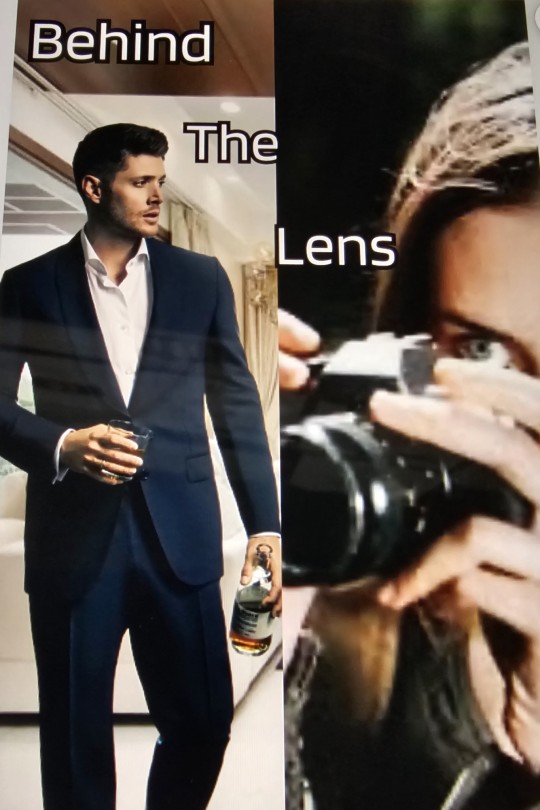
Summary.
"Behind the Lens" is a love story set in the summer of 2023, focusing on Jensen Ackles, a renowned actor facing the burden of stardom. Jensen's relentless dedication to his career has left him overwhelmed and disconnected from his true self. He's caught between his desire for a break and the pressure to maintain his public image. Through conversations with his manager, Darren, Jensen grapples with the need to find balance between his demanding career and personal well-being. This story explores the challenges of fame and the quest to rediscover one's passion in the entertainment industry. When he crosses path with a photographer Saamiya Siddiqiewill she be able to help him be the man he used to be?
Jensen Ackles x ofc Saamiya Siddiqie
Chapter one.
“Behind the Lens”
A Jensen Ackles and Saamiya Siddique Love Story
Written by Samantha Williams
Summer of 2023
Chapter One: Burden of Stardom
Jensen Ackles, renowned for his dedication and passion as an actor, saw his career soar to new heights over the years. However, the weight of his stardom took its toll as time went on. The constant demands of the entertainment industry, coupled with his perfectionist tendencies, led him down a path of exhaustion and inner turmoil.
At the beginning of his career, Jensen eagerly embraced every opportunity that came his way. He tackled premieres, interviews, and promotional events with enthusiasm, believing each appearance propelled him closer to his dreams. His determination to showcase his talent and worth to the world was unwavering. Yet, with escalating demands and skyrocketing fame, Jensen found himself consistently juggling numerous commitments. Endless film shoots, press tours, talk show appearances, charity events, and Supernatural convention weekends formed an unending list. It seemed as though he lived a life meticulously governed by a tightly controlled schedule, leaving only a few precious moments for himself before the next obligation arose. This rigid structure left him with scant time for genuine rest and relaxation.
As time passed, the unrelenting pressure to perform and maintain the charismatic and charming image the public adored eroded Jensen's sense of self. He felt as if he was in a perpetual role, even when off-screen, and genuine moments of respite and authenticity became increasingly rare. The more he pushed himself, the more his true identity seemed to slip through his fingers. Reluctance to attend events and interviews stemmed from a deep-rooted fear of losing himself entirely. He had heard stories of actors who had burned out, sacrificing their personal lives and well-being for the allure of fame. Becoming one of those cautionary tales was a fate he vehemently opposed. Despite this, he yearned for reality, for a connection to his craft that went beyond the glamour of the red carpet.
His desire for a break, a chance to catch his breath and reignite his passion, stemmed from his need to regain control over his life. The exhaustion he felt wasn't solely physical—it permeated his emotional and mental well-being. He longed for a space where he could delve into new roles without the suffocating weight of expectations. A space to rejuvenate his creativity and rediscover the joy that acting had once brought him.
Jensen's internal struggle was further exacerbated by his perfectionism. He held himself to incredibly high standards, consistently striving for excellence in his performances. This self-imposed pressure made it difficult for him to strike a balance between his career and self-care, ultimately leading to periods of burnout and frustration.
Currently, Jensen lounged on the plush couch in his comfortable Austin residence. His fingers tapped idly against the armrest as he gazed out the window. Beyond the glass, the muffled hum of the city provided a stark contrast to the tranquility he desperately sought. He ran a hand through his tousled hair, emitting a sigh as he glanced at the blinking notification light on his phone. He knew what lay in wait—a stern message from his manager, Darren Wright.
With a resigned expression, Jensen unlocked his phone and opened the message. The text stared back at him, sharp and unyielding:
“Jensen, we need to talk. Your recent absences from events and interviews are causing a stir. This is not the time to vanish, give me a call asap.” he had underlined asap and even bold-capped the words, that Jensen felt it was yelling.
Jensen bit his lip, the words hanging heavily in the air. He couldn't evade this conversation any longer. With a sigh, he dialed Darren's number, his thumb hovering over the call button. Each ring of the phone felt like a countdown to the impending confrontation.
"Jensen, finally decided to answer, huh?" Darren's voice crackled through the line, a blend of irritation and concern.
"Hey, Darren," Jensen greeted, aiming for casual despite the unease churning in his stomach.
"Skip the small talk, Jensen," Darren shot back. "We have a problem. Your recent absence from interviews, events, and that charity appearance last week—is causing a stir. Do you grasp the implications?"
Jensen reclined further, his gaze fixed on the ceiling. "I understand, Darren. I've been... overwhelmed."
"Overwhelmed?" Darren's voice sharpened. "Jensen, you're a top-tier actor. People count on you, and your disappearing act damages your image and our contracts."
"I get it, Darren. But you need to comprehend," Jensen's frustration bled into his words, "the ceaseless demands, the unending travel—it's draining. I need a breather."
"In this industry, you're not the sole one grappling with pressure, Jensen," Darren remarked. "But they don't vanish like you do. You hold responsibilities, commitments."
"I'm not seeking sympathy, Darren," Jensen's tone deepened. "I just need some time to recharge. To recollect why I embarked on this acting journey."
A tense silence settled over the line, the unspoken tension between artist and manager palpable. "Jensen," Darren's tone softened marginally, "I recognize the challenges. But you can't permit exhaustion to dictate your choices. We can adjust your schedule, and give you some leeway. But you must show up."
Jensen shut his eyes, weariness evident in the way he sank into the couch. "I don't want to lose sight of who I am, Darren. I refuse to metamorphose into a mere performance machine."
"Jensen, I understand. Truly," Darren's voice carried a hint of empathy. "We'll find a solution, alright? Yet, you must communicate. Vanishing in this manner won't solve anything."
Jensen nodded, even though Darren couldn't witness the gesture. "Yeah, you're right. I should have spoken to you before things escalated."
"Good. We'll address this," Darren's tone mellowed. "And remember, your public image is vital. People admire you."
As the conversation concluded, Jensen experienced a mixture of relief and residual tension. He acknowledged that Darren's perspective was valid; he couldn't permit exhaustion and frustration to steer his decisions. He needed to locate an equilibrium between his demanding career and personal well-being.
After ending the call, Jensen reclined further, his gaze fixated on the outside world passing by. Amidst the vortex of fame, he recognized he had misplaced his true self. He yearned for a reminder of the passion that had ignited his journey.
A couple of days later, Jensen's phone buzzed, displaying Darren's name on the screen. Sighing, he answered the call, his apprehension evident in his voice. "Hey, Darren."
"Jensen, good to catch you," Darren's tone was businesslike yet tinged with a hint of friendliness. "Listen, we've got an important photo shoot scheduled in New York."
Jensen's eyebrows furrowed. "Another one? Can't we reschedule it?"
Darren's sigh crackled through the phone. "Jensen, you know how crucial this is for your image. We've already rearranged the dates twice to accommodate your previous requests. It's time to show up."
Jensen's fingers tightened around the phone. "I understand, but I've been feeling really drained lately. I could use some time off."
"Jensen, I get that you're tired," Darren's voice softened, "but this is a big opportunity. It's for a prominent magazine cover, and the theme aligns perfectly with your upcoming project. It's a chance to showcase a different side of you."
Jensen leaned back, his eyes narrowing as he considered the proposition. "I know, but I just feel like I'm running on fumes here. I need a break."
Darren's patience seemed to wane slightly. "Jensen, we've discussed this. You're not the only one dealing with exhaustion. Everyone in this industry faces pressure. What sets you apart is how you handle it."
Jensen rubbed his temples, torn between his desire for a respite and the awareness of his professional responsibilities. "I'm worried about burning out, Darren. I don't want to reach a point where I can't even enjoy what I do."
“I hear you, we went over this ready the other day remember? I am truly working on it for you, just do this, then we will talk more.," Darren's voice carried understanding. "But think about why you started acting in the first place. Remember the passion, the thrill? This photo shoot could be a reminder of that."
Jensen let out a sigh, his resistance slowly giving way. "Fine, I'll do it. But can we keep it as concise as possible? I need some time to recharge afterward."
Darren's tone lightened. "Absolutely, We'll ensure the shoot is efficient, and then you can have a breather. Just remember, you're not alone in this. We're here to support you."
Jensen nodded, even though Darren couldn't see him. "Thanks, Darren. I appreciate your understanding."
"Get some rest before the trip, Jay.," Darren advised. "And remember, this shoot could be a turning point. Take it one step at a time."
As the call ended, Jensen leaned back, conflicted emotions swirling within him. He knew that relenting to the demands of his career was necessary, but he also realized that he needed to find a way to preserve his own well-being amidst the storm of fame. With a deep breath, he picked up his script and glanced at it, a reminder of the artistic passion that had driven him. He was determined to strike that balance—no matter how challenging it might be.
If you want to be tagged please let me know
@deans-baby-momma
#jensen ackles x reader#jensen ackles#reader insert#jensen ackles fanfiction#jared padalecki#supernatural rpf#dean winchester#reader fanfiction#photography#photography and reader#love story
18 notes
·
View notes
Text
Ladies, let’s reclaim cycling.
By Cara Eckholm
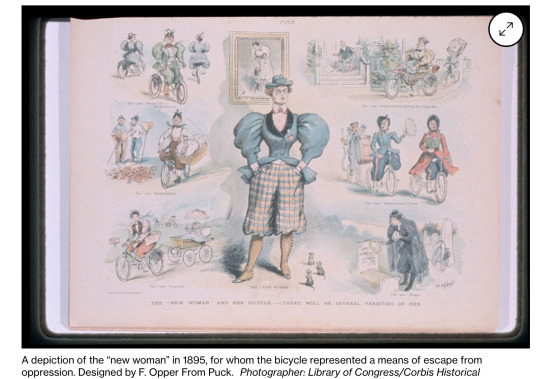
In the late 1880s, Victorian women became early adopters of the contemporary bicycle, and began to shed their corsets for bloomers. In 1896, American suffragette Susan B. Anthony wrote:
"I think [the bicycle] has done more to emancipate women than any one thing in the world. I rejoice every time I see a woman ride by on a bike. It gives her a feeling of self-reliance and independence the moment she takes her seat; and away she goes, the picture of untrammeled womanhood."
These early women cyclists helped cultivate the image of the “New Woman” — able to ride away from her household chores and oppression. Bike culture spawned a whole sartorial movement, chronicled through attractive ads of women in slick cycling gear.
But in today’s US cities, men cyclists vastly outnumber women. To fix the biking gender gap, we not only need better bike lane infrastructure but also to cultivate a new, aspirational image of the 21st century woman cyclist. On an e-bike, she carries her kids to school and rides on to work — and it’s cool, not an anomaly, that she’s doing it.
When it comes to biking, women are known as an “indicator species,” meaning the share of women cyclists is an indicator of whether a city is bike-friendly. In Copenhagen, where I spent my early twenties, women cyclists outnumber male cyclists, helping to popularize the term “cycle chic” to describe the local fashion aesthetic. I biked to work each morning in my suit and heels, and would pass mothers ferrying their toddlers to preschool in front-loaded cargo bikes. “The right to wind in your hair” became a calling card for an initiative to promote senior cycling.
By contrast, in US cities, male cyclists typically outnumber women cyclists two-to-one. That figure is even worse in my hometown, New York City: While biking to work has doubled in popularity over the last 10 years, the share of male-to-female commuters is stuck at a 3:1 ratio. These numbers are particularly striking given the affection many American women have for indoor cycling (women outnumber men on indoor bike trainers like Peloton.)
Why are US cities failing their female cyclists?
The answer is safety and social norms. After moving back to New York, I remember my first harrowing attempt to bike from Williamsburg to the Financial District, where I was working. I was berated by a driver who had parked in a bike lane, and had multiple near-death-by-car-door experiences. I was one of only a few women on the road as I dodged between cars and speeding men. When I finally arrived, I chained up my bike next to the Charging Bull, only to find it stolen by the evening.
Of course, safety concerns impact all genders, but research has found that women are more risk-averse in their decision of whether to bike. They have a right to be worried, according to Laura Fox, the former general manager of Citi Bike, the nation’s largest bike share program: One study showed that drivers are three times more likely to encroach on a female cyclist’s space than a male’s.
A key part of the solution is protected bike lanes, which are separated from cars by a physical barrier. A recent analysis of Citi Bike data found the installation of dedicated cycling infrastructure increased women’s cycling participation by an additional 4% to 6%. An even larger increase was observed on routes for which more than 80% of the mileage can be ridden on a protected path.
The good news is that there is finally funding for bike lane improvements. Through the Inflation Reduction Act, the federal government has dedicated $5 billion for the “Safe Streets and Roads for All” program, which is accepting grant applications until July 10. Now cities need to do the work of applying for funds and convincing neighborhoods to give up parking spaces for protected lanes. With cash in hand, cities should accelerate their bike lane roll-outs, concentrating those lanes along clear commuting paths.
The installation of new infrastructure should have a catalytic safety effect: Women tend to be slower bikers, and the more women bike, the more other diverse groups feel comfortable taking to the road. An effective and inclusive bike program has more clunky frames than 21-gear models, more riders donning work clothing than spandex.
Still, infrastructure alone won’t solve biking’s gender gap. Research has found that women tend to make more trips for household support activities than men — and that many women feel it is impossible to transport children or groceries by bike. (Cities like Portland have tried to address the issue by offering things like a “Shopping by Bike class.”) Women also tend to harbor concerns about how biking to work might impact workplace appearance.

The e-bike revolution could help in that process. The US e-bike market blossomed by 240% between 2020 and 2021, and is expected to keep growing as states pass e-bike tax rebates, similar to the federal rebate offered for electric vehicles. E-bikes eliminate much of the physical stress associated with biking, making it possible to carry cargo like children, and travel long distances without getting drenched in sweat. Even the Amish have caught on, with some choosing solar-powered e-bikes instead of horse-drawn-buggies for shopping trips.
E-bike companies have started to make sexy ads rivaling those in the car industry, but they still largely focus on selling to men, who today comprise the majority of e-bike ridership. Instead of a chiseled man in a suit weaving through traffic, I want to see a woman in a shift dress, riding calmly and carefully, removing her helmet to reveal alluring, tousled hair, as she steps into the store or the office. More “road models” like Beyoncé, who made headlines in 2013 when she commuted by bike to the Barclays Center for one of her performances.
Some 150 years ago, bikes freed the suffragettes from the hoop skirt. Earlier this month, David Byrne — the former frontman of the Talking Heads and a staunch bike lane advocate — arrived on a titanium bike at the Met Gala in a crisp white jacket. Meanwhile, a motorcade of luxury vehicles was caught behind a line of climate protesters, delaying celebrities like Paris Hilton, with their bedazzled outfits. Perhaps next year, some women will consider biking. I am willing to bike in heels and haute couture, if anyone wants to offer me a spare ticket.
Cara Eckholm is a Fellow at the Jacobs Urban Technology Hub at Cornell Tech. She is a bike commuter, formerly in Copenhagen, and now in New York City.
13 notes
·
View notes
Text
Psalm 23 (art by JA Swanson)
Two art pieces by John August Swanson, one of my favorite artists. I was delighted to meet him a few years before he died, and see many of his artworks in an exhibition.
This artwork was added as an embellishment to the 22 prints in the Peaceable Kingdom remarque edition and became the inspiration for the later artwork:

+++
This is John's later full-coler version: Psalm 23 (Serigraph, 2010)

Edition Size: 180 Completed: November 27, 2010 Image Size: 15.25″ x 24.25″ Paper: 100% cotton rag, acid free Colors: 47 Color Stencils
Artist's Notes:
Moving forward barefoot and without fear, two figures travel through a valley, transformed by their belief; it is a world where lions and lambs can lie together in peaceful harmony. The language of Psalm 23 carries a message of strength – Yea, though I walk through the valley of the shadow of death, I will fear no evil.
The forest, with deep shadows and darkness is a place filled with hidden sights and creatures. Since times long past, families and communities have sat around campfires and fireplaces to tell their legends. My mother told us stories of the forests and the mountains in Chihuahua, Mexico. My father’s family in Sweden spoke about the wild wolves in their local forest, as well as myths of forest people and ancient creatures. People understood the dangers of the wilderness. Travelers would seek to find shelter before the darkness of the night.
There is no moon in my image of the night, but the stars create a luminescence that helps those who are taking a journey. My vision contains the wonder and awe found in star-filled night skies. Our earliest ancestors may have gazed up to ponder the brilliance of these lights. They looked for order in the heavens, and marveled at the many wondrous and spectacular sights held within the glowing clusters of stars.
This story connects with our own lives, as we listen to those who encourage and empower others to speak out and stand against death, violence, and hate.
+++
The above 'Artist's Notes' is from this webpage at Swanson's website, along with documentation of 4 earlier versions of this Psalm 23 artwork: https://johnaugustswanson.com/catalog/psalm-23/
+++
John’s studio colleagues continue to promote his art here: https://www.facebook.com/JohnAugustSwansonStudio
“His art reflects the strong heritage of storytelling he inherited from his Mexican mother and Swedish father. John Swanson’s narrative is direct and easily understood. He addresses himself to human values, cultural roots, and his quest for self-discovery through visual images.” http://www.johnaugustswanson.com/
Remembering John August Swanson: a life dedicated to art, faith and justice https://www.americamagazine.org/arts-culture/2021/09/23/john-august-swanson-death-art-241485
0 notes
Text
Wellbeing posters - Get Your FREE Wellbeing Posters

Wellbeing Posters - Introduction
Wellbeing posters are visual art intended to inspire, motivate, and promote mental, emotional, physical, and spiritual health. Though motivational posters became popular in the 1980s and 90s as kitschy office decor, wellbeing posters have evolved into a genre focused on holistic health and personal growth. The purpose of wellbeing posters is to uplift and empower people. Images and text remind viewers of values like gratitude, mindfulness, self-care, relaxation, and human connection. Wellbeing posters can boost mood, reduce anxiety and stress, encourage healthy behaviors, inspire productivity and creativity, and bring focus to what really matters most. In recent years, the global pandemic led to a mental health crisis and increased focus on wellness. More people now recognize the importance of maintaining wellbeing and are turning to positive reminders and inspirational messages. As a result, wellbeing posters are becoming increasingly mainstream and can be found in homes, schools, offices, gyms, and more. The growing popularity of wellbeing posters reflects society's shift toward prioritizing health, relationships, meaning, and purpose.
Types of Wellbeing Posters
Wellbeing posters come in many different styles and focus areas to promote mental, physical, emotional, and spiritual health. Here are some of the most common types of wellbeing posters and their purposes: Motivational Posters Motivational posters typically feature an inspirational quote or phrase accompanied by an uplifting image. They are designed to provide encouragement, inspiration, and positivity to viewers. Motivational wellbeing posters may contain quotes about perseverance, self-belief, focusing on one's strengths, having a growth mindset, or overcoming challenges. They inspire viewers to pursue their goals and dreams. Affirmation Posters Affirmation posters display positive statements about oneself, often using "I am" phrases. Viewing affirmation posters regularly can help reinforce one's inner strengths, values, and self-beliefs. Common affirmation poster phrases include "I am capable", "I am at peace", "I am enough", and "I am worthy". Affirmation posters boost self-confidence and self-love. Wellbeing Posters - Mindfulness & Meditation These posters promote mindfulness, meditation, and inner tranquility. They often feature calming images of nature along with reminders to breathe, be present, embrace imperfection, and release anxiety or stress. Mindfulness posters encourage viewers to be fully engaged in the present moment. Gratitude Posters Gratitude posters cultivate appreciation for the simple gifts in life - a new day, nature, relationships, opportunities for growth, etc. They may also prompt viewers to reflect on specific things they are thankful for. Regularly focusing on gratitude boosts happiness and life satisfaction. https://wellbeinginyouroffice.com/why-is-gratitude-important Why is gratitude important: a game changer for mental health and wellbeing. Goals & Vision Boards Goal posters help maintain motivation and focus to achieve specific dreams and ambitions. Vision board posters display a collage of images that represent one's short and long term goals, serving as a constant visual reminder. Goals posters provide direction and purpose. Growth Mindset Posters Growth mindset posters reinforce the belief that one's abilities can be developed through dedication and hard work. They remind viewers that brains can get stronger and smarter through practice. Growth mindset posters encourage perseverance, lifelong learning, and viewing challenges as opportunities. Self-Care & Self-Love Posters These posters serve as uplifting reminders to engage in regular self-care activities to renew mental, emotional, and physical energy. They also promote self-acceptance, self-compassion, and self-love. Caring for oneself and appreciating one's inherent worth leads to greater wellbeing. https://wellbeinginyouroffice.com/free-mental-health-posters Free Mental Health Posters: Enhance Employee Wellbeing in Your Workplace
Benefits of Wellbeing Posters
Wellbeing posters can provide many benefits for your mental health, focus, and productivity. Studies have shown that positive imagery, affirmations, and reminders can lift your mood, reduce stress, and increase your ability to focus. Here are some of the top benefits of using wellbeing posters: Improved Mood Exposure to uplifting imagery and affirmations has been shown to boost mood. Whether it's a visually pleasing nature scene or an inspiring quote, surrounding yourself with feel-good messaging can increase happiness, reduce anxiety and depression, and cultivate more positive emotions. Wellbeing posters with bright colors, flowers, landscapes, or images can brighten your environment. Reduced Stress Posters with relaxing scenes, affirmations, or spiritual symbols can help activate the body's relaxation response. This lowers blood pressure, heart rate, and feelings of tension. Wellbeing posters can act as a simple stress management tool by providing a visual focal point for breathing, mindfulness, meditation or reflection. They promote inner calm and peace. Wellbeing Posters - Increased Engagement Studies show visual cues like motivational posters can increase energy, motivation, and focus. The reminders keep you in an engaged, empowered state of mind. Wellbeing posters with organisation tips, goals, habits, or growth mindset quotes help maintain concentration and clarity. This leads to higher efficiency and achieving more in less time. Greater Focus Posters with thought-provoking imagery give your mind something intriguing yet calming to rest upon. This activates parts of the brain involved in focus and concentration. Wellbeing posters in a workplace or study area grab your attention while also allowing a mental break. Rotating posters keeps your mind engaged. Reminders for Growth/Self-Care Wellbeing posters serve as helpful reminders to practice self-care, self-love, mindfulness, gratitude, and personal growth. When you constantly see inspirational quotes, affirmations, and visual cues, it reinforces developing beneficial habits. Posters can motivate you to drink more water, get exercise, reflect, or engage in stress-relieving activities. They provide encouragement through visual nudges.
Tips for Creating Your Own Wellbeing Posters
Creating your own wellbeing posters can be a fun and meaningful project. Here are some tips to get you started: - Choosing inspirational quotes or affirmations - Select messages that resonate with you and promote positivity, growth, gratitude or mindfulness. Famous quotes or your own inspirational words both work. - Selecting meaningful images - Choose photos, illustrations or graphic designs that connect to the message and make it more powerful. Nature scenes, motivational images, or uplifting artwork are great options. - Using bold colors and fonts - Opt for vivid, energizing colors and easy-to-read fonts that stand out. Avoid dull or dark hues. - Customizing to your needs - Tailor the posters to your personal goals, values and aesthetic preferences. Make them unique and fitting for your space. - Printable templates - Search online template sites for layouts you can customise with your own quotes, images and designs. Print them at home or through a digital printing service. Creating wellbeing posters is an enjoyable way to surround yourself with uplifting messages and images. Make the process creative and meaningful by choosing elements that inspire you and reflect your personality. https://wellbeinginyouroffice.com/wellbeing-at-work-initiatives Wellbeing at Work Initiatives – Your Guide to Employee Wellbeing
Displaying Wellbeing Posters
Wellbeing posters serve their purpose best when displayed prominently and thoughtfully. Consider where you and others will see them most frequently to maximize their impact. In the office, hang posters in break rooms, conference rooms, and offices where people gather. Ask about placing them in common spaces if your office has an open floor plan. When deciding how to display posters, framing is ideal for protection and an elevated look. Choose frame colors and styles that match your decor. Simple black or wood frames often work well for office settings, while metallic frames in gold and silver hues can brighten things up. For a bold statement, pick brightly colored frames that coordinate with your poster art. If framing isn't possible, you can also mount posters inexpensively using poster rails available at most hardware stores. These thin metal rails attach to your wall using adhesive strips or very small nails. Carefully insert the top edge of your poster into the rail to hold it in place. This allows you to rotate posters out periodically. For a more adaptable approach, consider using repositionable adhesive strips or magnets to hang unframed posters. This lets you easily move them from space to space. Just make sure the strips or magnets are strong enough to hold the poster weight without sagging or falling. To keep your poster display fresh, aim to swap out a few designs every several months. Store posters not on display in a folder or tube. Rotate your favorites back into the mix whenever it feels time for a change. You can also showcase wellbeing posters digitally using TV or computer screens. Create a slideslow of inspiring images and words to display in your living room or office reception area. Just be sure the resolution is high enough for clear viewing. Refresh it regularly since it's easy to overlook unchanged digital signage. Wellbeing posters have the most impact when we absorb their meaning in small doses over time.
Workplace Wellbeing Posters
Hanging wellbeing posters in the workplace is an easy way to create an uplifting environment. Wellbeing posters designed for the office can remind employees to take breaks, breathe deeply, stay hydrated, and maintain work-life balance. Motivational and inspirational quotes about teamwork, creativity, and perseverance also energise workers. Posters with images of nature scenes bring a sense of calm. Placing posters in high-traffic areas like kitchens, break rooms, and near restrooms means they will be seen often. Wellbeing tips near computer workstations encourage short stretching breaks for sore backs and wrists. Having multiple identical posters around large open floor plans spreads the message widely. Get leadership onboard by presenting wellbeing posters as an inexpensive way to boost engagement, satisfaction, and retention. Order enough identical posters so they can be displayed prominently in all areas and so the repetition reinforces their purpose. For a 50 person office, aim for at least 10-12 posters in total.

Creating a Wellbeing Poster Collection
Wellbeing posters can bring immense joy when displayed thoughtfully as a curated collection. Here are some tips for creating your own meaningful and inspiring wellbeing poster collection at home or work: Mixing and Matching Themes Don't limit yourself to just one visual theme or topic. Mixing and matching wellbeing posters with different inspirational sayings, soothing nature scenes, motivating mantras, and thought-provoking quotes creates visual interest. For example, you may combine stunning landscape photography with posters that feature wise sayings about gratitude or love.

Coordinating Frames and Colors While variety is good, ensure some cohesion in your collection by coordinating frames and colors. Black and white frames tend to work well together. You can also pick 2-3 coordinating colors for frames to tie everything together. Frames don't all need to match, but some consistency provides a polished look. Arranging a Gallery Wall When displaying multiple posters together in a gallery wall, think about the arrangement. Place the largest, most eye-catching posters in the center. Surround them with smaller pieces to build the composition outwards. Hang posters lower or higher, side-by-side or stacked vertically to add visual interest. Stand back frequently to evaluate the arrangement as you build your gallery wall. Wellbeing Posters - Digital Collections For those short on wall space, you can curate a digital collection of wellbeing posters and display them in a rotation as desktop or phone backgrounds. Curating Over Time Don't try to create your whole collection at once. Curate thoughtfully over time, adding special pieces that speak to you. Wellbeing posters make great gifts too. Build your collection slowly with intention, while staying true to your personal passions and style. Displaying a thoughtfully curated collection of wellbeing posters can lift your spirits and infuse any space with meaning. Follow these tips to create a collection you'll enjoy for years to come.





The Future of Wellbeing Posters
Wellbeing posters have come a long way, but their popularity and impact continue to grow. Here's what we can expect to see from wellbeing posters going forward. Continued Growth Expected Wellbeing posters are becoming increasingly mainstream and their use is expected to keep rising. Both individuals and organizations are discovering the benefits of displaying uplifting, inspiring and relaxing messaging. As mental health and self-care become higher priorities, wellbeing posters provide an easy way to promote positivity. New Technologies Digital frames may allow wellbeing posters to be displayed and cycled through electronically. This could provide more flexibility and opportunities to tailor content. Wellbeing posters could also incorporate lighting or movement. These innovations may enhance the mood-boosting abilities. More Workplace Adoption Offices and other work settings are embracing wellbeing posters more than ever before. They provide a subtle way to encourage self-care, relaxation and positive thinking throughout the workday. More workplaces are recognizing this and making posters part of their employee wellness initiatives. Focus on Diversity and Inclusion Future wellbeing posters will aim to resonate with broader, more diverse audiences. Campaigns will ensure posters reflect diverse populations and viewpoints. Wellbeing messaging is universal, but the images portrayed should represent the full spectrum of human experiences. Customization Trends As posters become more personalised, customers can select wellbeing messages and visuals tailored specifically to them. Posters can be customised for an individual's hobbies, values, or professional field. This makes the content more meaningful and impactful for the end user. Wellbeing posters have come a long way while still maintaining their core benefits. With an increased focus on mindfulness and mental health, these posters have a bright future ahead as both decorative and therapeutic tools. We can expect wellbeing posters to continue evolving and spreading more positive vibes.
Get your FREE Wellbeing Posters from Wellbeing in Your Office
Would you like a set of 8 beautifully designed digital Wellbeing Posters delivered directly to your inbox? Fill out the form below and you'll get all 8 of high resolution digital posters. *Please note that we don't provide printed posters, they're in digital form for you to print at your convenience .








Get your FREE Posters by signing up below
Read the full article
0 notes
Note
Hiì, can you do a Neymar X fem!reader when she is an actress and she was nominated for an Oscar
(they are like 26-27, davi in this is reader's son so they have been together since they were teenagers and she gave birth when she was 17.
And they have a daughter too)
you could describe how the night goes, how everyone are loving them, and then at the end she wins too.
Him being super supportive, everyone loves them, they meet other celebrities..
add what you feel it's right!!!
thank you if you’ll do it!!❤️❤️And also, l'm sorry if something it's not very clear, but l'm not a native speaker!!
#4. NEYMAR: THE OSCARS [requested]

SUMMARY: above
WARNINGS: angst (a little)
PAIRINGS: Neymar x female reader
I was nervous as hell. Being nominated for an Oscar for my first big role after pausing my career for my husband and kids for almost ten years, I had a feeling this event wouldn’t go too well for me. Neymar, sitting next to me in the limousine, noticed how anxious I got and intertwined his hand with mine. Before looking up at him, I watched him hold my hand for a second. The moment our eyes met I let out a loud sigh. He smiled at me softly, "Don't worry amorzinha, no matter what happens tonight, you wouldn’t even be nominated if you haven’t done this good [sweetheart]." I nodded, knowing he was right. I bit my bottom lip as I was getting flashbacks. "I just don’t want to disappoint or even embarrass myself being too hopeful. Last time I checked everyone hated on me."
In fact, I was born to be in front of the camera. Since I was a little child, I got booked for commercials and roles in movies. When I was 14 years old, I even had my own show and became a rolemodel for many younger girls. Eventually, everything changed when I met Neymar. We were filming a commercial together and fell in love. I was only 16 years old when I found out I was pregnant. Neymar, who was my first boyfriend – now being my boyfriend for over a decade –, and I already had a hard time dealing with personal issues, but the media interfering as soon as they found about me carrying his child, made it a lot harder. I lost all my jobs. The reason? I got slutshamed, I simply was a shame. I should’ve been a better rolemodel to my younger fans, they wanted me to take responsibility. But how was I supposed to do this when I still was a kid myself. Neymar, on the other side, got praised for being such a good father to our son, Davi, who I gave birth to at the age of 17. They respected him for continuing his career as a football player and still being able to take care of his little family. How ironic.
Since I had to raise our son, follow Neymar around the world and no one wanted to work with me anyway thanks to my bad image, I fully gave up on my acting career and decided I would just dedicate my life to my son and boyfriend. And honestly, I never regretted it, not even for a second.
On Davis fourth birthday I found out I was pregnant again. God blessed us with another angel, our babygirl Luana. Neymar and I couldn’t be happier. We had each other, we had our children and enjoyed every moment we were able to share with one another. On the other side though, Neymar always felt guilty for 'ruining' my career. That was the reason he tried to motivate me to apply for some roles when the kids were old enough. I couldn’t even imagine myself acting again, I wasn’t that confident and sure of myself anymore. But being Neymars girlfriend, I got a lot of offers for promoting products on social media or filming basic commercials. I had a hard time realising Davi and Luana were growing up, going to private school and following their hobbies instead of their mother taking care of and playing with them all day, so at some point, I decided to agree on filming a commercial - and the unexpected happened. I got booked for small roles in shows and movies, until I got the main role in a movie I felt like would be very big and popular, and I was right about that. It seemed like almost everyone forgot about my past and started loving and respecting me again after seeing me in the movie, which led to me being nominated for an Oscar as the best actress. It still felt unreal to me. I never would’ve imagined I'd be able to act again, let alone being nominated for a fucking Oscar.
"Meu amor, all this happened over ten years ago [my love]. Trust me, the respect towards you for being such an amazing mother to two children at a young age and still having such a comeback must be immense." If he only knew how much I loved him.
We arrived and I checked myself out in the selfie camera for the last time before getting out of the limousine, Neymar following closely behind me. All cameras were directed as us, the flash lights not stopping for a second. Neymar grabbed me by the waist and pulled me closer to him, posing for some photos. Instead of giving my attention to the cameras that were shoved right into our faces, I couldn’t help but stare at Neymar and smile widely as I repeatingly thought about how lucky I was to have him by my side. After me watching him for a few seconds, he looked down at me. His lips formed a big grin. "Eu te amo [I love you]", he whispered before giving me a short kiss, causing me to blush and chuckle a little. The second his lips touched mine, we heard everyone cheering and "aww"-ing.
The moment the nominees for the best actress got called out I swallowed hard. I breathed in and out heavily when I heard my name. Neymar picked up my hand, kissing the back of it. I appreciated him putting in effort to help me calm down, but I felt the tears forming in my eyes as I got more nervous with every passing second. "I just want this to finally end and go home", I whispered to him, taking another deep breath. He was trying to stay positive for me, but looking into his eyes, his nervousness and worries were obvious and clear to me. My heart was racing, I swear I could even hear it’s beating. The winner would get announced now. My eyes shut down, I faced the ground. I didn’t want the cameras to catch my disappointed crying face. Why would I be sad anyway? Getting an Oscar never was anything I expected. Suddenly, I heard applause and inaudible cheering around me. Did she just say my name? I quickly looked up but was unable to realise what was going on. Neymar jumped up, hands clapping, tears of joy were visible in his hazel eyes. My mouth fell open. This had to be a joke. Impossible. "Parabéns bebê, I'm so proud of you [congratulations baby]", Neymar dragged me up from my seat and hugged me tightly, kissing my cheek. I felt hot tears streaming down my face. The speech I held was absolute chaos, crying and stuttering, but still expressing how grateful I was.
"Oh. My. God", Neymar stuttered. We were at the after party enjoying ourselves. His favorite actor of all time, Will Smith, walked up to us. "Ney, Y/N", he greeted and hugged us, "Congratulations! I was so relieved the second your name was called. Your acting was just… wow! You really deserve it." I had to hold myself back from fangirling and squeaking, getting such a compliment from Will fucking Smith himself. We did some small talk and continued meeting some more of our idols throughout the whole night.
Yes, I won an Oscar that night, but the real win was the man I had by my side - always supporting me, motivating and inspiring me to do what’s best for me and loving me unconditionally.
#football imagine#football imagines#neymar#neymar imagine#neymar imagines#imagine#imagines#neymar jr#neymar junior#neymar x reader#neymar x you#neymar one shot#neymar jr x you#neymar jr x reader#neymar fluff#neymar headcanon#neymar blurb#neymar angst
503 notes
·
View notes
Text
TWST Characters if they were in Genshin Impact:
Heartslabyul Version
Riddle Rosehearts:
Vision: Pyro
Region: Mondstadt
Weapon Type: Sword
Occupation: Captain of a Cavalry Squad (Under Kaeya's command) & Head of Legal affairs of the Knight of Favonious
Story: When Riddle entered the Knights of Favonious he was promoted to become the captain of his own squadron within a week of joining. He also handles the legal affairs because of his vast knowledge of the law.
Vision Story: He obtained his vision when he was 12, studying hard per his mother's order to become a medical specialist when eventually he found his passion in learning about the law and order of things. Enforcing the law showed his passion in keeping everything in order and with that much dedication he was granted his vision.
Trey Clover:
Vision: Dendro
Region: Mondstadt
Weapon Type: Claymore
Occupation: Vice Captain of Riddle's Cavalry Squad & Baker.
Story: He entered the Knights of Favonious a year before Riddle and was in a different department. But when Riddle became a captain he was transferred to his squadron as the vice captain. He had known Riddle since they were children. He bakes pastries often and sometimes cook for the squad.
Vision Story: He lives with his family and his parents are bakers, he obtained his vision when Riddle was still training. It was when Riddle had been stressed and his reasoning wasn't in the right mind and he was there to handle it. His caring nature towards Riddle shone brightly and obtained a vision.
Cater Diamond:
Vision: Anemo
Region: Khaenri'ah (this is half a joke since Cater lives in the shaftlands which is compiled of different kinds of people I don't think I can put him in a normal region) But he moved to Mondstadt.
Weapon Type: Polearm
Occupation: Member of Riddle's Cavalry Squad & Photographer.
Story: After the destruction to Khaenri'ah his family managed to escape and took refuge in Mondstadt where he eventually entered the Knights of Favonious. He was born in Mondstadt and has little to no knowledge about the nation he originated from. He's quite close to Kaeya who knows of his origin.
Vision Story: He obtained his vision while he was training to become a Knight of Favonious. It was just another night after training. He always wondered what life would've been if his home country still stood tall. He always had an ideal image of what it would've been like. "I wonder what kind of picture I could take... Just to freely roam the country I could've been in." And with that Infront of him shone an Anemo Vision. His ideal image, his desire to see that nation gave him a vision.
Deuce Spade:
Vision: Cryo
Region: Mondstadt
Weapon Type: Claymore
Occupation: Rookie assigned under Riddle.
Story: He was once a troublemaker in Mondstadt making numerous residents dislike him, but one day he saw his mother crying and had decided to do better and started training to join the Knights of Favonious. It wasn't easy because of his reputation but somehow he pulled through and was put under Riddle's care.
Vision Story: It was a little after he joined, He was running errands outside of the city when he bumped into bad people, similar to the kind that he got tangled with before, it brought back bad memories and wanted to get away as soon as possible. But they weren't gonna have him get away, Deuce was beaten numerously by the thugs till he remembered why he was doing this, A cold air surrounded them and the beating he received was returned tenfold freezing them in place, That's when he saw the vision that he was given. He realized... It was another step taken to the path of redeeming himself for past mistakes.
Ace Trappola:
Vision: Pyro
Region: Mondstadt
Weapon Type: Sword
Occupation: Rookie assigned under Riddle.
Story: He was just any other young boy, dreaming of becoming a high ranking knight. His older brother was also a knight and was out on a mission with Grandmaster Varka. He was determined to surpass his brother.
Vision Story: It just happened... I'm just kidding, He got his vision much later than Deuce, he was frustrated and felt like he was falling behind everyone. Out training on his own to vent out some frustration and eventually let out a scream "I SWEAR TO THE ARCHONS IM GONNA BEAT YOU ALL" and just like that a fiery pyro vision... hit him on the head... next day he ran around showing it off.
#twisted wonderland#twst#heartslabyul#twisted wonderland imagines#twisted wonderland headcanons#riddle rosehearts#trey clover#cater diamond#ace trappola#deuce spade#long post
33 notes
·
View notes
Text
Michelangelo’s The Risen Christ: Discovering the sacred in the profane.
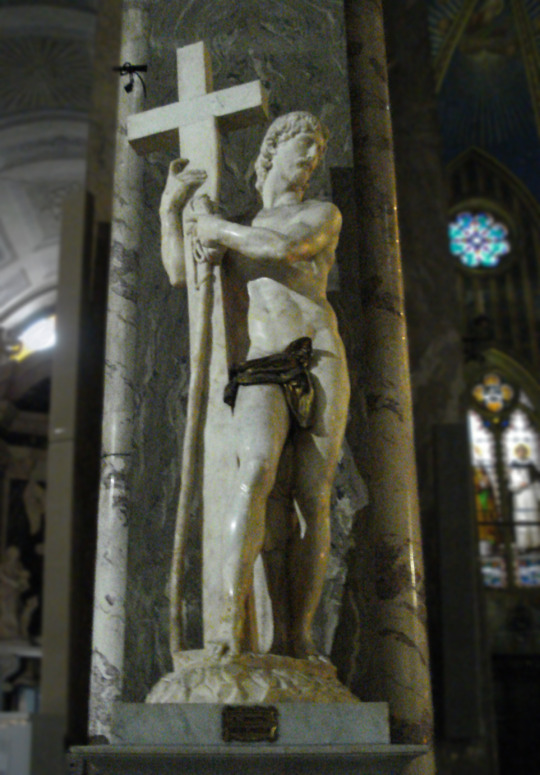
The true work of art is but a shadow of the divine perfection.
- Michelangelo Buonarroti
While a visit to Rome’s grand squares like Piazza Navona is at the top of everyone’s list, there is much more to the Eternal City. The Piazza della Minerva, is one of Rome’s more peculiar squares and is a must-see for lovers of Bernini’s work.
As one of the smaller squares in Rome, Piazza della Minerva holds some interesting sites. Built during Roman times, the square derives its name from the Goddess, Minerva, the Roman Goddess of wisdom and strategic warfare. During the 13th Century, the decision was made to build a Christian Church on top of what was once a square dedicated to a pagan Goddess – and so the church of Santa Maria Sopra Minerva was born, a beautiful example of Gothic architecture and Rome’s only Gothic church.

In fact this is the only Gothic church in Rome. It resembles the famous Church of Santa Maria Novella in Florence. There are three aisles inside the church. The soaring arches and the ceiling in blue are outstanding. The deep blue colours dominate the structure while the golden touches promote the intricate design. There are paintings of gold stars and saints. The stained glass windows are beautiful too.
In the centre of the Piazza is an elephant with an Egyptian obelisk on its back, one of Bernini’s last sculptures erected by Bernini for Pope Alexander VII and possibly one of the most unusual sculptures in Rome. There are several theories which aim to decipher Bernini’s inspiration for the sculpture, some of which point to Bernini’s study of the first elephant to visit Rome, while others point to a more satirical combination of a pagan stone with a baroque elephant in front of a Christian church.

Tourists flock to see the elephant but more often than not they miss out visiting an almost forgotten marble masterpeiece by Michelangelo himself inside the church. This controversial statue has resided in the Santa Maria sopra Minerva Church in Rome for almost five hundred years. Indeed The Risen Christ by Michelangelo is one of the artist's least admired works. While modern observers frequently have found fault with the statue, it satisfied its patrons enormously and was widely admired by contemporaries. Not least, the sculpture has suffered from the manner in which it is presently displayed and from biased photographic reproduction that emphasises unfavorable and inappropriate views of Christ.
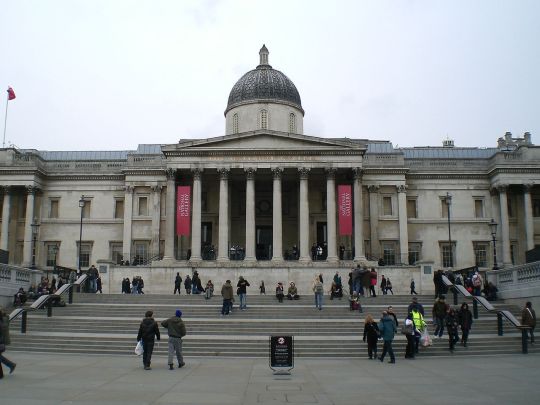
Around 2017 I was fortunate on a visit back to London to see once again Michelangelo’s marble masterpiece, The Risen Christ, which was being displayed in all its naked glory at an exhibition at the National Gallery.
This was another version of this great sculpture that no one has got round to covering up. It has just come to Britain. Michelangelo’s first version has been lent to the National Gallery, in London, for its exhibition Michelangelo and Sebastiano del Piombo in 2017. It came from San Vincenzo Monastery in Bassano Romano, where it languished in obscurity until it was recognised as Michelangelo’s lost work in 1997.

I found it profoundly moving then as I had seen the other partially clothed one on several visits to the church in Rome. It has always perplexed me why this beautiful work of art has been either shunned to the side with hidden shame or embarrassment when it holds up such profound sacred truth for both art lover or a Christian believer (or both as I am).
Michelangelo made a contract in June 1514 AD that he would make a sculpture of a standing, naked figure of Christ holding a cross, and that the sculpture would be completed within four years of the contract. Michelangelo had a problem because the marble he started carving was defective and had a black streak in the area of the face. His patrons, Bernardo Cencio, Mario Scapucci, and Metello Vari de' Pocari, were wondering what happened when they hadn't heard for a while from Michelangelo. Michelangelo had stopped work on The Risen Christ due to the blemish in the marble, and he was working on another project, the San Lorenzo facade. Michelangelo felt grief because this project of The Risen Christ was delayed. Michelangelo ordered a new marble block from Pisa which was to arrive on the first boat. When The Risen Christ was finally finished in March 1521 AD Michelangelo was only 46 years old.

It was transported to Rome and this 80.75 inches tall marble statue was installed at the left pillar of the choir in the church Santa Maria sopra Minerva, by Pietro Urbano, Michelangelo's assistant (Hughes, 1999). It turns out that Urbano did a finish to the feet, hands, nostrils, and beard of Christ, that many friends of Michelangelo described as disastrous). Furthermore, later-on in history, nail-holes were pierced in Christ's hands, and Christ's genitalia were hidden behind a bronze loincloth.
Because people have changed this sculpture over time; many are disappointed with this work of art because it is presently different than the original work that Michelangelo made. The Risen Christ had no title during Michelangelo's lifetime. This sculpture was given the name it has now, because Christ is standing like the traditional resurrected saviour, as seen in other similar works of art.
It was in discussion with an art historian friend of mine currently teaching I was surprised through her to discover the sculpture’s uncomfortably controversial history. There is no doubt Michelangelo’s marvellous marble creation has raised robust debates about where beauty as an aesthetic sits between the sacred and the profane. And nothing exemplifies that better than the phallus on Michelangelo’s The Risen Christ.
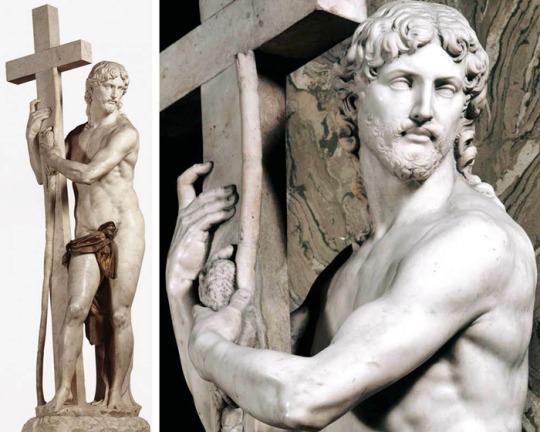
For the majority of its time there, however, the phallus has been carefully draped with a bronze loincloth - incongruous at best, and prudish at worst, but either way a less than subtle display of the historic Church’s discomfort with the full physicality of Christ.
Indeed, it is worth noting that this attitude prevails, at least in some sense, into the twentieth-century: the version of the statue in Rome remains covered to this day, and much of the critical attention the sculpture has received after Michelangelo’s death has been grating. Romain Rolland, an early biographer, described it as ‘the coldest and dullest thing he ever did’, whilst Linda Murray bluntly dubbed the work ‘Michelangelo’s chief and perhaps only total failure’. But Michelangelo himself saw no such mistake. The censored statue seen in Santa Maria sopra Minerva is what we might call his second draft.
It’s interesting to note that when artist was originally commissioned to sculpt a risen Christ in 1514, he had all but completed it before realising that a vein of black marble ran across Jesus’ face, marring the image of classical perfection which he so wished to emulate. It had nothing to do with the phallus. Furious, Michelangelo abandoned this Christ - the one I saw at the National Gallery - and began again. Even given a fresh chance, he chose to retain Christ’s complete nudity.
Why was this of such importance to Michelangelo? Why did he so strongly wish to craft the literal manhood of Christ, as never depicted before? Part of the answer may lie in his historical context: the Renaissance in Italy was driven in the part by the remains of Roman antiquity discovered there; study of the classics became commonplace, and scholars tended to consider the Graeco-Roman world as a cultural ideal, with ancient art in particular being emblematic of a lost Golden Age. Famously, classical sculpture was almost always nude.

In his interview with The Telegraph in 2015, Ian Jenkins, curator of the British Museum exhibition “Defining Beauty: The Body in Ancient Greek Art”, attempted to explain this tradition. ‘The Greeks … didn’t walk down the High Street in Athens naked … But to the Greeks [nudity] was the mark of a hero. It was not about representing the literal world, but a world which was mythologised.’
We see evidence for this trend in Greek literature as well as sculpture: Homer’s Iliad and Odyssey, considered by some to be the earliest known works of Western literature, were likely written between the 8th and 7th centuries BC, but their setting is in Mycenaean Greece in the 12th century. The Greeks believed that this earlier Bronze Age was an epoch of heroism, wherein gods walked the earth alongside mortals and the human experience was generally more sublime. In setting the texts at this earlier stage in Greece’s history, Homer echoes the belief held within his contemporary society that mankind had been better before (what we might now call nostalgia, or, more colloquially, “The Good Old Days syndrome”). There is a real feeling of delight present in the distance Homer creates between his actual, flawed society, and the idealised past.
Indeed, it calls to mind a line I once read in an introduction to L.P. Hartley’s The Go-Between, by Douglas Brookes-Davies: ‘Memory idealises the past’. Though modernist texts such as The Go-Between problematise this, in antiquity it was not only commonplace but celebrated to look back to a more perfect existence and relive it through art. The very fact that Michelangelo abandoned his sculpture after years of work on account of a barely noticeable flaw in the marble is evidence that he, too, was striving towards the classical ideal of perfection. ‘Unfortunately,’ Hazel Stanier has commented, ‘this has resulted in unintentionally making Christ appear like a pagan god.’

This opens up another question – why does such a rift exist between the way ancient cultures envisaged their divinity and our own conceptions of a Christian God? Why are we not allowed to anthropomorphise the deus of the Bible in the same way that the Roman gods were?
Christ, of course, makes this somewhat confusing, given that he is described in the Bible as ‘the Word made flesh’, a physical and very human incarnation of the spiritual being that we call God. Theology tells us that he is fully human and fully divine, and yet the Church have excluded him from many aspects of life that a majority of us see as typifying a human being. Christ has no apparent sexual desires or romantic relationships, and though not exempt from suffering, he does not play any part in sin (which, as the saying goes, is ‘only human’). I think that the enormous controversy caused by films such as The Last Temptation of Christ (1988), which explore the possibility of Jesus having a sex life, is reflective of the possibility that - though in theory the Christian messiah is fully human - we feel significant discomfort at the notion that he may have explored particular aspects of the human experience.
Purists and the prude and liberals rush to opposite sides of the debate. If purists run one way to completely deny Christ had any sexual desires or even inclinations as all humans are want to do, liberals commit the sin of rushing to the other extreme end and presuppose that Jesus did act on sexual impulses simply because it was inevitable of his human nature.
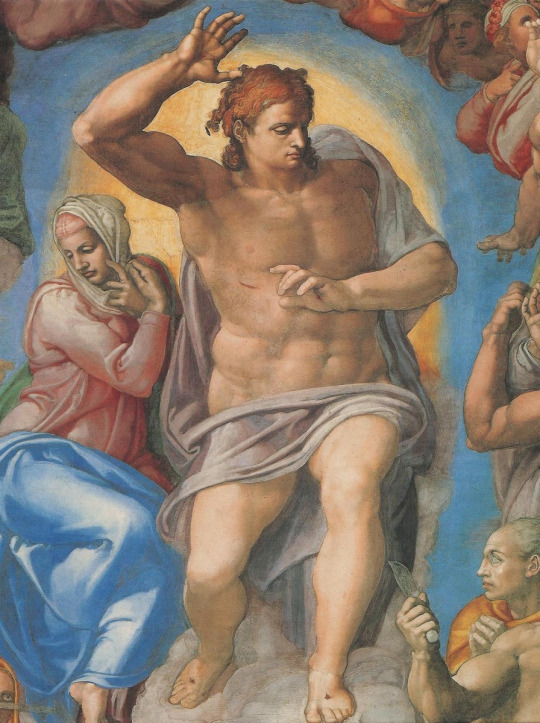
I think the truth lies somewhere between but what that truth might actually be is simply speculation on my part. It doesn’t detract for me the life and saving mission of redemption that Jesus was on - to suffer and die for our sins as well as the Godhead reconciling itself to sacrificing the Son for Man’s sins and just punishment.
Of course, it is well-known that the classical gods had no qualms about sexual activity. It is difficult to make retrospective judgements about citizens’ opinions on this but, as it was the norm, we might assume that they felt it was rather a non-issue. I can empathise with some critics who reason that the Christian God is not entitled to sexual expression is because of the traditional Christian idea that sex is inherently sinful – that original sin is passed on seminally and so by having sex we continue to spread darkness and provoke further transgression. It is from this early idea that theological issues such as the need for Mary to have been immaculately conceived (she was not created out of a sexual union, much like her son) have stemmed. But here - the immaculate conception - the critics are profoundly wrong in their theological understanding of why God had to enter the world as Immanuel in this miraculous way.
Some Christian critics - and I would agree with them - assert that the vision of a naked Christ might make a powerful theological point in a world where sex still carries these connotations. They rightly point out that clothing - and I might extend this to mean the covering-up of the sexual parts of our body - was only adopted by humankind after the Fall, the nudity of Christ is making a statement about his unfallen nature as the second Adam. In other words, Christ has no shame, because he is sinless and has no need for shame. Perhaps what Michelangelo intended was actually to disentangle nudity from its sexual, sinful associations, instead presenting us with a pre-lapsarian image of purity taking the form of the classical Bronze Age hero.
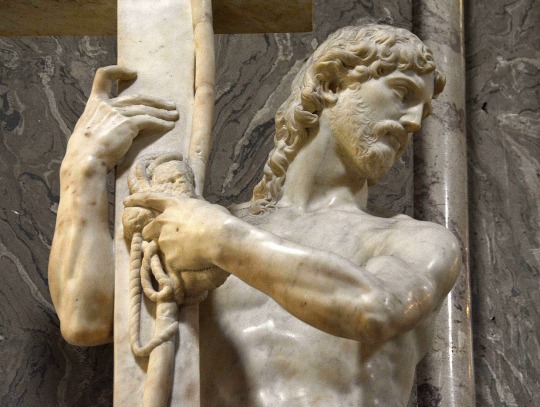
There is another, less theological explanation for the sculptor’s obvious use of the classical form. It reminds us of a time when gods walked the earth alongside us, when they were fully human – us, only immortal. Maybe he wanted to emphasise that fully human aspect of Christ’s being. Questionable as much of their behaviour was, the classical gods were certainly easy to identify with. For Michelangelo, this may have been his own way of embodying John 1:14 in marble: ‘The Word became flesh and made his dwelling among us’.
It is here critics may have gotten hold of the wrong end of the stick with The Risen Christ when they point out the odd proportions of the figure: that it has a weighty torso, or the broad hips atop a pair of tapered and rather spindly legs, or even a side or rear view of the figure that show Christ’s buttocks.
For a start, this ungainly rear view was not supposed to be seen. The statue was meant to go in a wall niche, so that the back of the statue was hidden. Michelangelo of course knew this, and shaped the statue so that it would appear well proportioned from the front. If we view the sculpture from the front left, perhaps its best side, then Christ is no longer a thickset figure. Rather, his body merges with the cross in a graceful and harmonious composition.
The turn of Christ’s body and his averted face suggest something like the shunning of physical contact that is central to another post-Resurrection subject, the Noli me tangere (“Touch Me Not”). The turned head is a poignant way of making Christ seem inaccessible even as the reality of his living flesh is manifest.
We are encouraged to look at not Christ’s face, but the instruments of his Passion. Our attention is directed to the cross by the effortless cross-body gesture of the left arm and the entwining movement of the right leg. With his powerful but graceful hands, Christ cradles the cross, and the separated index fingers direct us first to the cross and then heavenward. Christ presents us with the symbols of his Passion – the tangible recollection of his earthly suffering. Behind Christ and barely visible between his legs we see the cloth in which Christ was wrapped when he was in the tomb. He has just shed the earthly shroud; it is in the midst of slipping to earth. In this suspended instant, Christ is completely and properly nude.

We must imagine how the figure must have appeared in its original setting, within the darkened confines of an elevated niche. Christ steps forth, as though from the tomb and the shadow of death. Foremost are the symbols of the Passion, which Christ will leave behind when he ascends to heaven.
Why was Michelangelo compelled to portray Christ completely naked in a way that was bound to trouble some Christians? It was not out of a desire to blaspheme. On the contrary, this genius – poet, architect and painter as well as the greatest sculptor who has ever lived – was not only a faithful Christian but someone who thought deeply about theology. You can bet he had good religious reasons to depict Christ in full nudity.
But it would be complacent to think there was no tension in showing Christ nude. The fact that The Risen Christ in Santa Maria still has its covering proves how real those tensions are. The fundamental reason Michelangelo could get away with it was that he was Michelangelo. By the time he created this statue, he had the Sistine Chapel ceiling (with all its male nudes) under his belt and was the most famous artist in the world.
For centuries, the faithful have kissed the advanced foot of Christ, for like Mary Magdalene and doubting Thomas, they wish for some sort of physical contact with the Risen Christ. To carve a life-size marble statue of a naked Christ certainly was audacious, but it is also theologically appropriate. Michelangelo’s contemporaries recognised, more easily than modern viewers, that the Risen Christ was a moving and profoundly beautiful sculpture that was true to the sacred story.
#the risen christ#michelangelo#marble#church#christian#beauty#aesthetics#statue#religious#renaissance#history#rome#bernini#art#arts#culture#society#religion#sculpture
201 notes
·
View notes
Text
A retrospective on some of Broadway’s most important female costume designers across the last century
How much is our memory or perception of a production influenced by the manner in which we visually comprehend the characters for their physical appearance and attire? A lot.
How much attention in memory is often dedicated to celebrating the costume designers who create the visual forms we remember? Comparatively, not much.
Delving through the New York Public Library archives of late, I found I was able to zoom into pictures of productions like Sunday in the Park with George at a magnitude greater than before.
In doing so, I noticed myself marvelling at finer details on the costumes that simply aren’t visible from grainy 1985 proshots, or other lower resolution images.
And marvel I did.

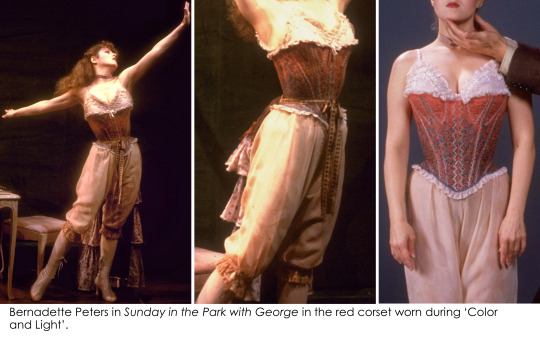
At first, I began to set out to address the contributions made to the show by designer Patricia Zipprodt in collaboration with Ann Hould-Ward. Quickly I fell into a (rather substantial) tangent rabbit hole – concerning over a century’s worth of interconnected designers who are responsible for hundreds of some of the most memorable Broadway shows between them.
It is impossible to look at the work of just one or two of these women without also discussing the others that came before them or were inspired by them.
Journey with me then if you will on this retrospective endeavour to explore the work and legacy that some of these designers have created, and some of the contexts in which they did so.
A set of podcasts featuring Ann Hould-Ward, including Behind the Curtain (Ep. 229) and Broadway Nation (Eps. 17 and 18), invaluably introduce some of the information discussed here and, most crucially, provide a first-hand, verbal link back to this history. The latter show sets out the case for a “succession of dynamic women that goes back to the earliest days of the Broadway musical and continues right up to today”, all of whom “were mentored by one or more of the great [designers] before them, [all] became Tony award-winning [stars] in their own right, and [all] have passed on the [craft] to the next generation.”
A chronological, linear descendancy links these designers across multiple centuries, starting in 1880 with Aline Bernstein, then moving to Irene Sharaff, then to Patricia Zipprodt, then to the present day with Ann Hould-Ward. Other designers branch from or interact with this linear chronology in different ways, such as Florence Klotz and Ann Roth – who, like Patricia Zipprodt, were also mentored by Aline Bernstein – or Theoni V. Aldredge, who stands apart from this connected tree, but whose career closely parallels the chronology of its central portion. There were, of course, many other designers and women also working within this era that provided even further momentous contributions to the world of costume design, but in this piece, the focus will remain primarily on these seven figures.

As the main creditor of the designs for Sunday in the Park with George, let’s start with Patricia (Pat) Zipprodt.
Born in 1925, Pat studied at the Fashion Institute of Technology (FIT) in New York after winning a scholarship there in 1951. Through teaching herself “all of costume history by studying materials at the New York Public Library”, she passed her entrance exam to the United Scenic Artists Union in 1954. This itself was a feat only possible through Aline Bernstein’s pioneering steps in demanding and starting female acceptance into this same union for the first time just under 30 years previously.
Pat made her individual costume design debut a year after assisting Irene Sharaff on Happy Hunting in 1956 – Ethel Merman’s last new Broadway credit. Of the more than 50 shows she subsequently designed, some of Pat’s most significant musicals include: She Loves Me (1963) Fiddler on the Roof (1964) Cabaret (1966) Zorba (1968) 1776 (1969) Pippin (1972) Mack & Mabel (1974) Chicago (1975) Alice in Wonderland (1983) Sunday in the Park with George (1984) Sweet Charity (1986) Into the Woods (1987) - preliminary work
Other notable play credits included: The Little Foxes (1967) The Glass Menagerie (1983) Cat on a Hot Tin Roof (1990)

Yes. One person designed all of those shows. Many of the most beloved pieces in modern musical theatre history. Somewhat baffling.
Her work notably earned her 11 Tony nominations, 3 wins, an induction into the Theatre Hall of Fame in 1992, and the Irene Sharaff award for lifetime achievement in costume design in 1997.
By 1983, Pat was one of the most well-respected designers of her era. When the offer for Sunday in the Park with George came in, she was less than enamoured by being confined to the ill-suited basements at Playwright’s Horizons all day, designing full costumes for a story not even yet in existence. From-the-ground-up workshops are common now, but at the time, Sunday was one of the first of its kind.
Rather than flatly declining, she asked Ann Hould-Ward, previously her assistant and intern who had now been designing for 2-3 years on her own, if she was interested in collaborating. She was. The two divided the designing between them, like Pat creating Bernadette’s opening pink and white dress, and Ann her final red and purple dress.

Which indeed leads to the question of the infamous creation worn in the opening number. No attemptedly comprehensive look at the costumes in Sunday would be complete without addressing it or its masterful mechanics.
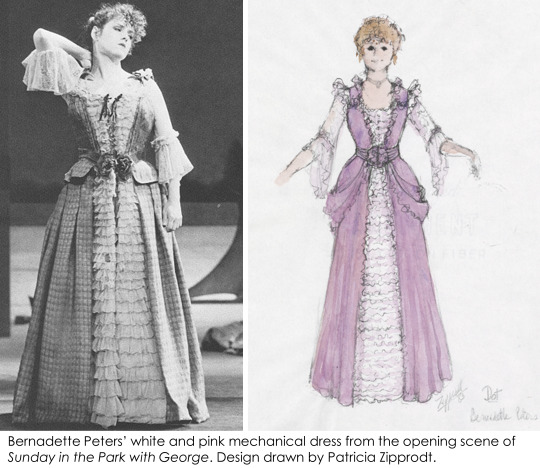
To enable Bernadette to spring miraculously and seemingly effortlessly from her outer confines, Ann and Pat enlisted the help of a man with a “Theatre Magics” company in Ohio. Dubbed ‘The Iron Dress’, the gasp-inducing motion required a wire frame embedded into the material, entities called ‘moonwalker legs and feet’, and two garage door openers coming up through the stage to lever the two halves apart. The mechanism – highly impressive in its periods of functionality – wasn’t without its flaws. Ann recalls “there were nights during previews where [Bernadette] couldn’t get out of the dress”. Or worse, a night where “the dress closed up completely. And it wouldn’t open up again!”. As Bernadette finished her number, there was nothing else within her power she could do, so she simply “grabbed it under her arm and carried it off stage.”
What visuals. Evidently, the course of costume design is not always plain sailing.
This sentiment is exhibited in the fact design work is a physical materialisation of other creators’ visions, thus foregrounding the tricky need for collaboration and compromise. This is at once a skill, very much part of the job description, and not always pleasant – in navigating any divides between one’s own ideas and those of other people.
Sunday in the Park with George was no exception in requiring such a moment of compromise and revision. With the show already on Broadway in previews, Stephen Sondheim decreed the little girl Louise’s dress “needs to be white” – not the “turquoisey blue” undertone Pat and Ann had already created it with. White, to better spotlight the painting’s centre.
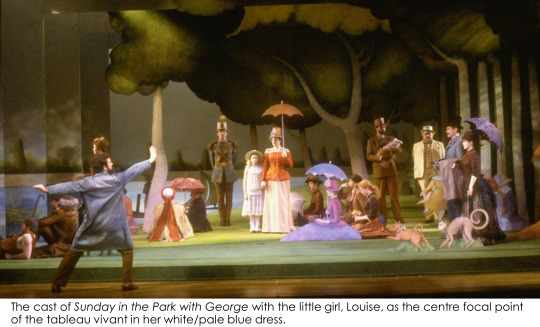
Requests for alterations are easier to comprehend when they are done with equanimity and have justification. Sondheim said he would pay for the new dress himself, and in Seurat’s original painting, the little girl is very brightly the focal centre point of the piece. On this occasion, all agreed that Sondheim was “absolutely right”. A new dress was made.
Other artistic differences aren’t always as amicable.
In Pat Zipprodt’s first show, Happy Hunting with Ethel Merman in 1956, some creatives and directors were getting in vociferous, progress-stopping arguments over a dress and a scene in which Ethel was to jump over a fence. Then magically, the dress went missing. Pat was working at the time as an assistant to the senior Irene Sharaff, and Pat herself was the one to find the dress the next morning. It was in the basement. Covered in black and wholly unwearable. Sharaff had spray painted the dress black in protest against the “bickering”. Indeed, Sharaff disappeared, not to be seen again until the show arrived on Broadway.
Those that worked with her soon found that Sharaff was one to be listened to and respected – as Hal Prince did during West Side Story. After the show opened in 1957, Hal replaced her 40 pairs of meticulously created and individually dyed, battered, and re-dyed jeans with off-the-rack copies. His reasoning was this: “How foolish to be wasting money when we can make a promotional arrangement with Levi Strauss to supply blue jeans free for program credit?” A year later, he looked at their show, and wondered “What’s happened?”
What had happened was that the production had lost its spark and noticeable portions of its beauty, vibrancy, and subtle individuality. Sharaff’s unique creations quickly returned, and Hal had learned his lesson. By the time Sharaff’s mentee, Pat, had “designed the most expensive rags for the company to wear” with this same idiosyncratic dyeing process for Fiddler on the Roof in 1964, Hal recognised the value of this particularity and the disproportionately large payoff even ostensibly simple garments can bring.

Irene Sharaff is remembered as one of the greatest designers ever. Born in 1910, she was mentored by Aline Bernstein, first assisting her on 1928’s original staging of Hedda Gabler.
Throughout her 56 year career, she designed more than 52 Broadway musicals. Some particularly memorable entities include: The Boys from Syracuse (1938) Lady in the Dark (1943) Candide (1956) Happy Hunting (1956) Sweet Charity (1966) The King and I (1951, 1956) West Side Story (1957, 1961) Funny Girl (1964, 1968)
For the last three productions, she would reprise her work on Broadway in the subsequent and indelibly enduring film adaptations of the same shows.
Her work in the theatre earned her 6 Tony nominations and 1 win, though her work in Hollywood was perhaps even more well rewarded – earning 5 Academy Awards from a total of 15 nominations.
Some of Sharaff’s additional film credits included: Meet Me in St. Louis (1944) Ziegfeld Follies (1946) An American in Paris (1951) Call Me Madam (1953) A Star is Born (1954) – partial Guys and Dolls (1955) Cleopatra (1963) Who’s Afraid of Virginia Woolf? (1966) Hello Dolly! (1969) Mommie Dearest (1981)
It’s a remarkable list. But it is too more than just a list.
Famously, Judy’s red scarlet ballgown in Meet Me in St. Louis was termed the “most sophisticated costume [she’d] yet worn on the screen.”
It has been written that Sharaff’s “last film was probably the only bad one on which she worked,” – the infamous pillar of camp culture, Mommie Dearest, in 1981 – “but its perpetrators knew that to recreate the Hollywood of Joan Crawford, it required an artist who understood the particular glamour of the Crawford era.” And at the time, there were very few – if any – who could fill that requirement better than Irene Sharaff.
The 1963 production of Cleopatra is perhaps an even more infamous endeavour. Notoriously fraught with problems, the film was at that point the most expensive ever made. It nearly bankrupted 20th Century Fox, in light of varying issues like long production delays, a revolving carousel of directors, the beginning of the infamous Burton/Taylor affair and resulting media storm, and bouts of Elizabeth’s ill-health that “nearly killed her”. In that turbulent environment, Sharaff is highlighted as one of the figures instrumental in the film’s eventual completion – “adjusting Elizabeth Taylor’s costumes when her weight fluctuated overnight” so the world finally received the visual spectacle they were all ardently anticipating.

But even beyond that, Sharaff’s work had impacts more significantly and extensively than the immediate products of the shows or films themselves. Within a few years of her “vibrant Thai silk costumes for ‘The King and I’ in 1951, …silk became Thailand’s best-known export.” Her designs changed the entire economic landscape of the country.
It’s little wonder that in that era, Sharaff was known as “one of the most sought-after and highest-paid people in her profession.” With discussions and favourable comparisions alongside none other than Old Hollywood’s most beloved designer, Edith Head, Irene deserves her place in history to be recognised as one of the foremost significant pillars of the design world.
In this respected position, Irene Sharaff was able to pass on her knowledge by mentoring others too as well as Patricia Zipprodt, like Ann Roth and Florence Klotz, who have in turn gone on to further have their own highly commendable successes in the industry.
Florence “Flossie” Klotz, born in 1920, is the only Broadway costume designer to have won six Tony awards. She did so, all of them for musicals, and all of them directed by Hal Prince, in a marker of their long and meaningful collaboration.
Indeed, Flossie’s life partner was Ruth Mitchell – Hal’s long-time assistant, and herself legendary stage manager, associate director and producer of over 43 shows. Together, Flossie and Ruth were dubbed a “power couple of Broadway”.
Flossie’s shows with Hal included: Follies (1971) A Little Night Music (1973) Pacific Overtures (1976) Grind (1985) Kiss of the Spiderwoman (1993) Show Boat (1995)
And additional shows amongst her credits extend to: Side by Side by Sondheim (1977) On the Twentieth Century (1978) The Little Foxes (1981) A Doll’s Life (1982) Jerry’s Girls (1985)
Earlier in her career, she would first find her footing as an assistant designer on some of the Golden Age’s most pivotal shows like: The King and I (1951) Pal Joey (1952) Silk Stockings (1955) Carousel (1957) The Sound of Music (1959)
The original production of Follies marked the first time Florence was seriously recognised for her work. Before this point, she was not yet anywhere close to being considered as having broken into the ranks of Broadway’s “reigning designers” of that era. Follies changed matters, providing both an indication of the talent of her work to come, and creating history in being commended for producing some of the “best costumes to be seen on Broadway” in recent memory – as Clive Barnes wrote in The New York Times. Fuller discussion is merited given that the costumes of Follies are always one of the show’s central points of debate and have been crucial to the reception of the original production as well as every single revival that has followed in the 50 years since.

In this instance, Ted Chapin would record from his book ‘Everything Was Possible: The Birth of the Musical ‘Follies’ how “the costumes were so opulent, they put the show over-budget.” Moreover, that “talking about the show years later, [Florence] said the costumes could not be made today. ‘Not only would they cost upwards of $2 million, but we used fabrics from England that aren’t even made anymore.’” Broadway then does indeed no longer look like Broadway now.
This “surreal tableau” Flossie created, including “three-foot-high ostrich feather headdresses, Marie Antoinette wigs adorned with musical instruments and birdcages, and gowns embellished with translucent butterfly wings”, remains arguably one of the most impressive and jaw-dropping spectacles to have ever graced a Broadway stage even to this day.
As for Ann Roth, born in 1931, she is still to this day making her own history – recently becoming the joint eldest nominee at 89 for an Oscar (her 5th), for her work on 2020′s Ma Rainey’s Black Bottom. Now as of April 26th, Ann has just made history even further by becoming the oldest woman to win a competitive Academy Award ever. She has an impressive array of Hollywood credits to her name in addition to a roster of Broadway design projects, which have earned her 12 Tony nominations.
Some of her work in the theatre includes: The Women (1973) The Best Little Whorehouse in Texas (1978) They're Playing Our Song (1979) Singin' in the Rain (1985) Present Laughter (1996) Hedda Gabler (2009) A Raisin in the Sun (2014) Shuffle Along (2016) The Prom (2018)
Making her way over to Hollywood in the ‘70s, she has left an indelible and lasting visual impact on the arts through films like: Klute (1971) The Goodbye Girl (1977) Hair (1979) 9 to 5 (1980) Silkwood (1983) Postcards from the Edge (1990) The Birdcage (1996) The Hours (2002) Mamma Mia! (2008) Ma Rainey’s Black Bottom (2020)

It’s clear from this branching 'tree' to see how far the impact of just one woman passing on her time and knowledge to others who are starting out can spread.
This art of acting as a conduit for valuable insights was something Irene Sharaff had learned from her own mentor and predecessor, Aline Bernstein. Aline was viewed as “the first woman in the [US] to gain prominence in the male-dominated field of set and costume design,” and was too a strong proponent of passing on the unique knowledge she had acquired as a pioneer and forerunner in the field.
Born in 1880, Bernstein is recognised as “one of the first theatrical designers in New York to make sets and costumes entirely from scratch and craft moving sets” while Broadway was still very much in its infancy of taking shape as the world we know today. This she did for more than one hundred shows over decades of her work in the theatre. These shows included the spectacular Grand Street Follies (1924-27), and original premier productions of plays like some of the following: Ibsen’s Hedda Gabler (1928) J.M Barrie’s Peter Pan (1928) Grand Hotel (1930) Phillip Barry’s Animal Kingdom (1932) Chekov’s The Seagull (1937) Both Lillian Hellman’s The Children’s Hour (1934) and The Little Foxes (1939)
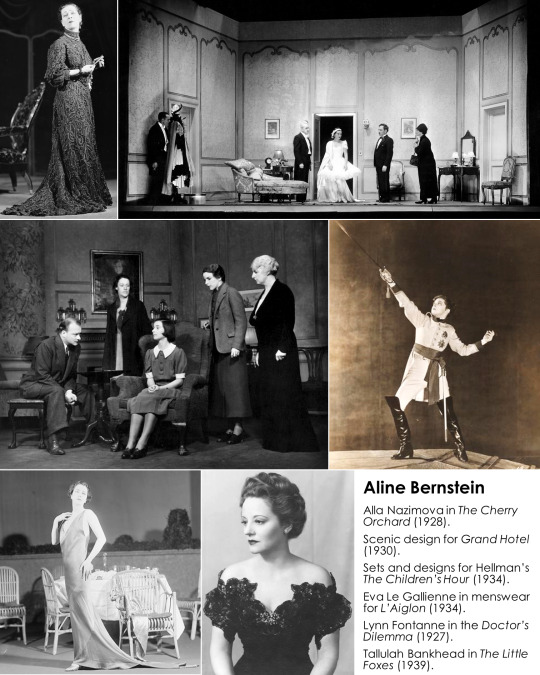
Beyond direct design work, Bernstein founded what was to become the Neighbourhood Playhouse (the notable New York acting school) and was influential in the “Little Theatre movement that sprung up across America in 1910”. These were the “forerunners of the non-profit theatres we see today” and she continued to work in this realm even after moving into commercial theatre.
Bernstein also established the Museum of Costume Art, which later became the Costume Institute of the Met Museum of Art, where she served as president from 1944 to her death in 1955. This is what the Met Gala raises money for every year. So for long as you have the world’s biggest celebrities parading up and down red carpets in high fashion pieces, you have Aline Bernstein to remember – as none of that would be happening without her.
During the last fifteen years of her life, Bernstein taught and served as a consultant in theatre programs at academic institutions including Yale, Harvard, and Vassar – keen to connect the community and facilitate an exchange of wisdom and information to new descendants and the next generation.
Many designers came somewhere out of this linear descendancy. One notable exception, with no American mentor, was Theoni V. Aldredge. Born in 1922 and trained in Greece, Theoni emigrated to the US, met her husband, Tom Aldredge – himself of Into the Woods and theatre notoriety – and went on to design more than 100 Broadway shows. For her work, she earned 3 Tony wins from 11 nominations from projects such as: Anyone Can Whistle (1964) A Chorus Line (1975) Annie (1977) Barnum (1980) 42nd Street (1980) Woman of the Year (1981) Dreamgirls (1981) La Cage aux Folles (1983) The Rink (1984)
One of the main features that typify Theoni’s design style and could be attributed to a certain unique and distinctive “European flair” is her strong use of vibrant colour. This is a sentiment instantly apparent in looking longitudinally at some of her work.

In Ann Hould-Ward’s words, Theoni speaks to the “great generosity” of this profession. Theoni went out of her way to call Ann apropos of nothing early in the morning at some unknown hotel just after Ann won her first Tony for Beauty and the Beast in 1994, purring “Dahhling, I told you so!” These were women that had their disagreements, yes, but ultimately shared their knowledge and congratulated each other for their successes.
Similar anecdotal goodwill can be found in Pat Zipprodt’s call to Ann on the night of the 1987 Tony’s – where Ann was nominated for Into the Woods – with Pat singing “Have wonderful night! You’re not gonna win! …[laugh] but I love you anyway!”
This well-wishing phone call is all the more poignant considering Pat was originally involved with doing the costumes for Into the Woods, in reprise of their previous collaboration on Sunday in the Park with George.
If, for example, Theoni instinctively is remembered for bright colour, one of the features that Pat is first remembered for is her dedicated approach to research for her designs. Indeed, the New York Public Library archives document how the remaining physical evidence of this research she conducted is “particularly thorough” in the section on Into the Woods. Before the show finally hit Broadway in 1987 with Ann Hould-Ward’s designs, records show Pat had done extensive investigation herself into materials, ideas and prospective creations all through 1986.
Both Ann and Pat worked on the show out of town in try-outs at the Old Globe theatre in San Diego. But when it came to negotiating Broadway contracts, the situation became “tricky” and later “untenable” with Pat and the producers. Ann was “allowed to step in and design” the show alone instead.
The lack of harboured resentment on Patricia’s behalf speaks to her character and the pair’s relationship, such that Ann still considered her “my dear and beloved friend” for over 25 years, and was “at [Pat’s] bed when she died”.
Though they parted ways ultimately for Into the Woods, you can very much feel a continuation between their work on Sunday in the Park with George a few years previously, especially considering how tactile the designs appear in both shows. This tactility is something the shows’ book writer and director, James Lapine, was specific about. Lapine would remark in his initial ideas and inspirations that he wanted a graphic quality to the costumes on this occasion, like “so many sketches of the fairy-tales do”.
Ann fed that sentiment through her final creations, with a wide variety of materials and textures being used across the whole show – like “ribbons with ribbons seamed through them”, “all sorts of applique”, “frothy organzas and rembriodered organzas”. A specific example documents how Joanna Gleason’s shawl as the Baker’s Wife was pieced together, cut apart, and put back together again before resembling its final form.
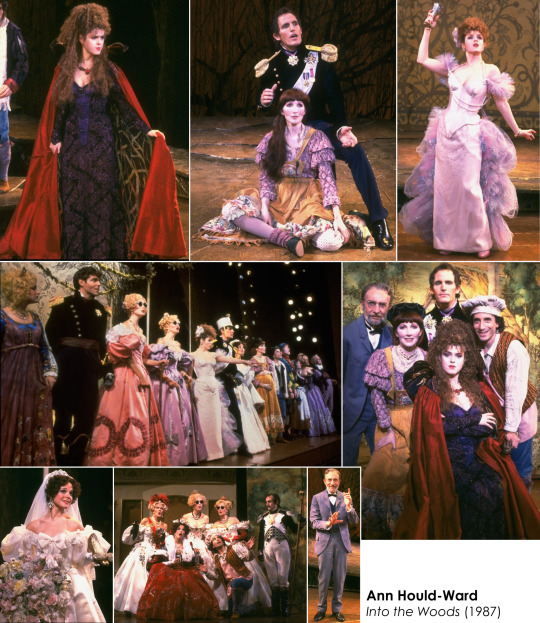
This highly involved principle demonstrates another manner of inventive design that uses a different method but maintains the aim of particularity as discussed previously with Patricia and Irene’s complex dyeing and re-dyeing process. Pushing the confines of what is possible with the materials at hand to create a variety of colours, shades, and textures ultimately produces visual entities that are complex to look at. Confusing the eye like this “holds attention longer”, Ann maintains, which makes viewers look more intricately at individual segments of the production, and enables the costume design to guide specific focus by not immediately ceding attention elsewhere.
Understanding the methods behind the resultant impacts of a show can be as, if not more, important and interesting than the final product of the show itself sometimes. A phone call Ann had last August with James Lapine reminds us this is a notion we may be treated more to in the imminent future, when he called to enquire as to the location of some design sketches for the book he is working on (Putting It Together: How Stephen Sondheim and I Created 'Sunday in the Park with George') to document more thoroughly the genesis of the pair’s landmark and beloved musical.
In continuation of the notion that origin stories contain their own intrinsic value beyond any final product, Ann first became Pat’s intern through a heart-warming and tenacious tale. Ann sent letters to three notable designers when finishing graduate school. Only Patricia Zipprodt replied, with a message to say she “didn’t have anything now but let me think about it and maybe in the future.” It got to the future, and Ann took the encouragement of her previous response to try and contact Pat again. Upon being told she was out of town with a show, Ann proceeded to chase Pat through various phone books and telephone wires across different states and theatres until she finally found her. She was bolstered by the specifics of their call and ran off the phone to write an imploring note – hinging on the premise of a shared connection to Montana. She took an arrow, stabbed it through a cowboy hat, put it in a box with the note that was written on raw hide, and mailed it to New York with bated breath and all of her hopes and wishes.
Pat was knife-edgingly close to missing the box, through a matter of circumstance and timing. Importantly, she didn’t. Ann got a response, and it boded well: “Alright alright alright! You can come to New York!”
Subsequently, Ann’s long career in the design world of the theatre has included notable credits such as: Sunday in the Park with George (1984) Into the Woods (1987, 1997) Falsettos (1992) Beauty and the Beast (1994, 1997) Little Me (1998) Company (2006) Road Show (2008) The People in the Picture (2011) Merrily We Roll Along (1985, 1990, 2012, segment in Six by Sondheim 2013) Passion (2013) The Visit (2015) The Color Purple (2015) The Prince of Egypt (2021)
From early days in the city sleeping on a piece of foam on a friend’s floor, to working collaboratively alongside Pat, to using what she’d learnt from her mentor in designing whole shows herself, and going on to win prestigious awards for her work – the cycle of the theatre and the importance of handing down wisdom from those who possess it is never more evident.
As Ann summarises it meaningfully, “the theatre is a continuing, changing, evolving, emotional ball”. It’s raw, it’s alive, it needs people, it needs stories, it needs documentation of history to remember all that came before.
In periods where there can physically be no new theatre, it’s made ever the more clear for the need not to forget what value there is in the tales to be told from the past.
Through this retrospective, we’ve seen the tour de force influence of a relatively small handful of women shaping a relatively large portion of the visual scape of some of Broadway’s brightest moments.
But it’s significant to consider how disproportionate this female impact was, in contrast with how massively male dominated the rest of the creative theatre industry has been across the last century.
Assessing variations in attitudes and approaches to relationships and families in these women in the context of their professional careers over this time period presents interesting observations. And indeed, manners in which things have changed over the past hundred years.
As Ann Hould-Ward speaks of her experiences, one of her reflections is how much this was a “very male dominated world”. And one that didn’t accommodate for women with families who also wanted careers. As an intern, she didn’t even feel she could tell Patricia Zipprodt about the existence of her own young child until after 6 months of working with her. With all of these male figures around them, it would be often questioned “How are you going to do the work? How are you going to manage [with a family]?”, and that it was “harder to convince people that you were going to be able to do out-of-towns, to be able to go places.” Simply put, the industry “didn't have many designers who were married with children.”
Patricia herself in the previous generation demonstrates this restricting ethos. “In 1993, Zipprodt married a man whose proposal she had refused some 43 years earlier.” She had just newly graduated college and “she declined [his proposal] and instead moved to New York.” Faced with the family or career conundrum, she chose the latter. By the 1950s, it then wasn’t seen as uncommon to have both, it was seen as impossible.
Her husband died just five years after the pair were married in 1998, as did Patricia herself the following year. One has to wonder if alternative decisions would’ve been made and lives lived differently if she’d experienced a different context for working women in her younger life.
But occupying any space in the theatre at all was only possible because of the efforts of and strides made by women in previous generations.
When Aline Bernstein first started designing for Broadway theatre in 1916, women couldn’t even vote. She became the first female member of the United Scenic Artists of America union in 1926, but only because she was sworn in under the false and male moniker of brother Bernstein. In fact, biographies often centralise on her involvement in a “passionate” extramarital love affair with novelist Thomas Wolfe – disproportionately so for all of her remarkable contributions to the theatrical, charitable and academic worlds, and instead having her life defined through her interactions with men.
As such, it is apparent how any significant interactions with men often had direct implications over a woman’s career, especially in this earlier half of the century. Only in their absence was there comparative capacity to flourish professionally.
Irene Sharaff had no notable relationships with men. She did however have a significant partnership with Chinese-American painter and writer Mai-mai Sze from “the mid-1930s until her death”. Though this was not (nor could not be) publicly recognised or documented at the time, later by close acquaintances the pair would be described as a “devoted couple”, “inseparable”, and as holding “love and admiration for one another [that] was apparent to everyone who knew them.” This manner of relationship for Irene in the context of her career can be theorised as having allowed her the capacity to “reach a level of professional success that would have been unthinkable for most straight women of [her] generation”.
Moving forwards in time, Irene and Mai-mai presently rest where their ashes are buried under “two halves of the same rock” at the entrance to the Music and Meditation Pavilion at Lucy Cavendish College in Cambridge, which was “built following a donation by Sharaff and Sze”. I postulate that this site would make for an interesting slice of history and a perhaps more thought-provoking deviation for tourists away from being shepherded up and down past King’s College on King’s Parade as more usually upon a visit to Cambridge.
In this more modern society at the other end of this linear tree of remarkable designers, options for women to be more open and in control of their personal and professional lives have increased somewhat.
Ann Hould-Ward later in her career would no longer “hide that [she] was a mother”, in fear of not being taken seriously. Rather, she “made a concerted effort to talk about [her] child”, saying “because at that point I had a modicum of success. And I thought it was supportive for other women that I could do this.”
If one aspect passed down between these women in history are details of the craft and knowledge accrued along the way, this statement by Ann represents an alternative facet and direction that teaching of the future can take. Namely, that by showing through example, newer generations will be able to comprehend the feasibility of occupying different options and spaces as professional women. Existing not just as designers, or wives, or mothers, or all, or one – but as people, who possess an immense talent and skill. And that it is now not just possible, but common, to be multifaceted and live the way you want to live while working.
This is not to say all of the restrictions and barriers faced by women in previous generations have been removed, but rather that as we build a larger wealth of history of women acting with autonomy and control to refer back to, things can only get easier to build upon for the future.
Who knows what Broadway and theatre in general will look like when it returns – both on the surface with respect to this facet of costume design, and also more deeply as to the inner machinations of how shows are put together and presented. The largely male environment and the need to tick corporate and commercial boxes will not have vanished. One can only hope that this long period of stasis will have foregrounded the need and, most importantly, provided the time to revaluate the ethos in which shows are often staged, and the ways in which minority groups – like women – are able to work and be successful within the theatre in all of the many shows to come.
Notable sources:
Photographs – predominantly from the New York Public Library digital archives. IBDB – the Internet Broadway Database. Broadway Nation Podcast (Eps. #17 and #18), David Armstrong, featuring Ann Hould-Ward, 2020. Behind the Curtain: Broadway’s Living Legends Podcast (Ep. #229), Robert W Schneider and Kevin David Thomas, featuring Ann Hould-Ward, 2020. Sense of Occasion, Harold Prince, 2017. Everything Was Possible: The Birth of the Musical ‘Follies’, Ted Chapin, 2003. Finishing the Hat: Collected Lyrics (1954–1981) with Attendant Comments, Principles, Heresies, Grudges, Whines and Anecdotes, Stephen Sondheim, 2010. The Complete Book of 1970s Broadway Musicals, Dan Deitz, 2015. The Complete Book of 1980s Broadway Musicals, Dan Dietz, 2016. Inventory of the Patricia Zipprodt Papers and Designs at the New York Public Library, 2004 – https://www.nypl.org/sites/default/files/archivalcollections/pdf/thezippr.pdf Extravagant Crowd’s Carl Van Vecten’s Portraits of Women, Aline Bernstein – http://brbl-archive.library.yale.edu/exhibitions/cvvpw/gallery/bernstein.html Jewish Heroes & Heroines of America: 150 True Stories of American Jewish Heroism – Aline Bernstein, Seymour Brody, 1996 – https://www.jewishvirtuallibrary.org/aline-bernstein Ann Hould-Ward Talks Original “Into the Woods” Costume Designs, 2016 – https://www.youtube.com/watch?v=4EPe77c6xzo&ab_channel=Playbill American Theatre Wing’s Working in the Theatre series, The Design Panel, 1993 – https://www.youtube.com/watch?v=9sp-aMQHf-U&t=2167s&ab_channel=AmericanTheatreWing Journal of the History of Ideas Blog, Mai-mai Sze and Irene Sharaff in Public and in Private, Erin McGuirl, 2016 – https://jhiblog.org/2016/05/16/mai-mai-sze-and-irene-sharaff-in-public-and-in-private/ Irene Sharaff’s obituary, The New York Times, Marvine Howe, 1993 – https://www.nytimes.com/1993/08/17/obituaries/irene-sharaff-designer-83-dies-costumes-won-tony-and-oscars.html Obituary: Irene Sharaff, The Independent, David Shipman, 2011 – https://www.independent.co.uk/news/people/obituary-irene-sharaff-1463219.html Broadway Design Exchange – Florence Klotz – https://www.broadwaydesignexchange.com/collections/florence-klotz Obituary: Florence Klotz, The New York Times, 2006 – https://www.nytimes.com/2006/11/03/obituaries/03klotz.html
#bernadette peters#sunday in the park with george#costume design#costume designers#stephen sondheim#sondheim#broadway#theatre#tony awards#oscars#academy award nominations#ethel merman#judy garland#into the woods#theater#musical theater#fashion#dresses#meryl streep#elizabeth taylor#old hollywood#film#costumes#movies#musicals#writing#long reads#hollywood#actresses
163 notes
·
View notes
Text

i can be temptation, you can be my sin
Pairing: Jimin x Fem!Reader
Rating: 18+
Word Count: 4.5k
Genre: smut, tiny side of angst and fluff, office!au (not the TV show), coworkers!au
Warnings: unprotected sex (wrap it before you tap it), dom!Jimin, sub!reader, spanking, fingering, semi-public sex, dirty talk, degradation, reader sends nudes
Summary: Between bragging about his prolific sex life and his horrific design ideas, Jimin has managed to make your work life a living hell. Then one little accident sends you hurtling towards him, and as hard as you try, you can’t seem to stop yourself.
A/N: This is a commission for @ppersonna for @ficswithluv‘s ChangesWithLuv project dedicated to raising money for BLM. I’m so sorry this fic took forever to write (I’m not sure why), but I hope that you enjoy it! A huge shout-out to my lovely beta-reader, @jinterlude. She’s the best!
| m.list |
“Jimin…” a groan tumbles out of you, “that shade of yellow is-“
“Bright and comforting?”
“-awful.”
His thick lips curve into a pout, eyes doing little to conceal his mock hurt. Exasperation runs through your body, grasping your brain in its clutches. Your entire week has been filled with Jimin’s progressively hideous design ideas for a book cover, to the point you’re beginning to wonder how he got hired at all. The piss-yellow mock-up in front of you is just another straw in the stack that is going to break your back.
“What?” he looks confused, “You said you wanted something eye-catching, and I would have to say this is pretty darn, eye-catching.”
“It’s blinding is what it is. Maybe if we toned it back a bit…” your eyes drift over the design, horror twisting in your gut.
You want to cry. A week ago, your boss had enthusiastically paired you with Jimin to design a book cover for an up and coming YA author, claiming the two of you were the best designers she had, even promising the both of you a promotion if things went well. You aren’t sure what designs Jimin had produced in the past, because what he was bringing to the table now wasn’t much better than a shitty college club poster.
Jimin didn’t make for great company either. Sure he had legs that went for miles, and a face that would outshine angels, but his mouth was filthy. If the two of you weren’t bickering over fonts and hex codes, you were stuck listening to him brag about how loud he could make a girl scream. What’s worse is that while your brain was logical enough to know that Jimin was no good for you, your body had other ideas. As a result, you often went home after a long day, frustrated in more ways than one.
With a little luck- and quite a bit of compromising- you manage to make it to five ‘o’clock without murdering anyone. You manage to talk Jimin down off the yellow in exchange for completing the pitch presentation by yourself. Presentations are time-consuming and tedious, but it’s better than being out of a job because Jimin is set on making the cover look like a neon highlighter.
A half an hour later, you're collapsing on your soft couch, ready to do absolutely nothing for the rest of the weekend. A sigh of relief carries an iota of the stress out of your body as you sink back into the welcoming cushions. You grimace as the tension in your neck became apparent, and you feel the growing ball of angst you have for Jimin tighten. You were going to send him the bill if you had to go to a chiropractor.
In an attempt to move on from your hectic week and into your relaxing weekend, you wander to the kitchen, searching for the merlot you have yet to open. The tall green bottle greets you from the counter. You find a glass and watch as the red liquid quickly fills it. You savor a long sip as you let your mind stray away from the thoughts of work and stress and into notions of self-care and relaxation.
An hour later, having eaten a frozen pizza, you find yourself soaking down into the hot bath suds. The heat begins to draw the ache out of your sore muscles. Once again, Jimin flashes through your mind, coupled with resentment. Your eyes prickle at the thought, sick and tired of Jimin living in your mind rent-free. Why is he preoccupying your brain instead of Seokjin, the cute cook you matched with on Tinder?
While you had yet to meet in person, you and Seokjin had hit off right away when he opened with the cheesiest pick-up line you’d ever heard. He worked at a five-star restaurant a few blocks from your office, but you’d never met in person. That didn’t mean that you hadn’t had a few scandalous conversations. You weren’t usually one for sexting, but Seokjin’s way with words left you little choice.
Eager to take Jimin off your mind, you grab your phone from the side of the tub, quickly opening your messages. You’re much too impatient for small talk, so in the interest of sparking some saucy dialogue, you take a few snaps of your bubble-covered nude body. You suck in a breath as you hit send, anxious for your reaction. It wasn’t the first time you had sent him a nude photo, but it didn’t make you any less nervous. Seokjin was one of the most attractive men you had ever had the privilege of laying eyes on, and it was only natural for you to question your appearance in comparison to his. He would always reassure you, though, flattering you with compliments, both sultry and sweet.
When he doesn’t respond fifteen minutes, a knot forms in your stomach. What if he didn’t like them? What if he was seeing someone else? What if he lost interest? You check your messages with hurried concern. What you find on your screen mortifies. In your haste to tease Seokjin, you had accidentally sent the photos to the last person you texted: Jimin. Worse yet, the little grey “read” sits just beneath the last picture. As you stare at the screen with abject horror, a little speech-bubble pops-up. Your stomach twists in knots, anticipating of what he might say striking you with fear.
The Office Brat: if you wanted a piece of me baby girl, all you had to do was ask 20:33
You suck in a breath when he immediately follows the text with a picture of his own. He’s shirtless, lip between his teeth as he grabs his prominent erection through grey sweatpants. You can’t help the whine that slips out of your mouth at the image. You try to ignore the heat that rushes to your core as your legs rub together. When your senses finally return to you, you drop your phone on the bath mat before sinking into the water, leaving only your face out. The photo is still seared into your brain, taunting you with his delicious abs and what turned out to be a healthy sized dick.
You immediately resolve to forget it ever happened. You spend the rest of the weekend attempting to distract yourself through a binge of every cheesy rom-com you can find on Netflix. You sent Jimin a quick text, informing him that the photos weren’t actually for him. He hadn’t responded, and you didn’t know if you should be relieved or not. It certainly didn’t aid the dread building in your stomach at the thought of having to face him again on Monday.
When you walk into the office two days later, you’re relieved to find that Jimin seemed nowhere to be found. You pray that he actually had an iota of shame and quit out of humiliation. Your hopes are crushed when not five minutes later, you notice him prancing toward your cubicle, his ever-present smirk plastered across his face. When he reaches you, he plops down in an extra desk chair, arms crossed across his chest, eyes looking you up and down. You can’t help but shiver at the knowledge that he knows precisely what you look like underneath your work clothes.
“What do you want, Jimin?” you sigh.
“Haven’t I made that obvious, baby?” He grins. “I want you.”
You roll your eyes.
“Jimin, what happened this weekend was an accident,” you give him a firm glare, “so no matter how much you claim to want me, I want nothing to do with you.:
He raises his eyebrow, eyes locked on yours, before standing and walking to you. His breath is warm on your neck as he leans over to whisper in your ear. You clench your thighs in an attempt to extinguish the heat beginning to burn in between them.
“We’ll see about that, now won’t we, baby girl?”
He pulls away with a smirk, before turning to head to his desk. Your eyes trail to his ass as he leaves, only worsening the situation in your underwear. You silently vow to yourself not to fall for his tricks. You have more self-respect than to allow yourself to be yet another notch in Park Jimin’s bedpost.
Brushing thoughts of your troublesome coworker from your mind, you turn back to your bright computer screen, determined to lose yourself in your work. Your eyes widen when you find an email from Jimin taunting you in your inbox. Heart pounding fast, you click on it, half afraid to find another nude of his (it wouldn’t be beyond him). Instead of a naked Jimin, a PDF with the details for the cover design presents itself. You’re taken aback. Not only had Jimin swapped the yellow for soft coral, but he practically redesigned the entire thing. Scrolling through, you’re embarrassed to admit that it was nearly as good, if not better, then some of your best works.
You immediately realize that this means he’s been pulling your leg for over a week. A groan escapes you, and your head falls forward, smashing into your keyboard. Of course, he was a fucking amazing graphic artist; you shouldn’t have expected anything less. Fury floods down your spine as it dawns on you that it was all a trick to get out of doing the PowerPoint. Now you were stuck making an entire presentation, just because Jimin had pretended to love piss-yellow.
It takes every ounce of your self-control not to march to his desk and strangle him. White anger flashes in front of your eyes, resentment growing to cover every waking thought in your brain. When you finally calm enough to rationalize that murder isn’t going to get you anywhere, you decide that your best course of action is to avoid him until the day of the two of you are scheduled to present to the board.
The world isn’t being kind to you today, because when you finally head to the break room for lunch, you immediately run into your new worst enemy.
“What’s got your panties in a knot now, love?”
You glare at him, not trusting yourself not to stab him with your salad fork. He smirks in response, before turning to leave. At the last second, he turns back to you.
“Have fun with that PowerPoint.”
You want to scream.
“Jimin, I swear to god, you little shit, I’m gonna-”
“You’re gonna what? Spank me?” His cheeky grin widens. “You know, baby, I’m usually a dom, but if it meant feeling your sweet pussy, I’d definitely be a sub.”
You are lucky that no one else is around to hear his words because you are mortified enough. Red creeps across your face as Jimin winks at you. When he finally leaves, you collapse back onto the counter, trying to get a grip on your surroundings. You swear to high heaven that you’ve never hated someone so much in your life, yet feel so attracted to them at the same time. As infuriated as you are with him, you are even more infuriated with your inability to control your body’s reaction to him.
Why did he have to know exactly what to say to soak your panties? Why was he so hellbent on getting you to sleep with him? Why did you ever have to be assigned to him in the first place? These questions plagued your mind as the week trickled slowly on. Your anger with Jimin was beginning to be diluted with anxiety about your upcoming presentation. No part of you looked forward to standing in front of the company board to make a potential career-changing pitch with the person you hated most in the world. Not to mention public speaking made you want to hide under a rock and never come out.
Thankfully, Jimin is kind enough to offer to do most of the talking- even if his original deal included a blow job- but it also meant you had less control if things started to go south. By the time Friday rolled around, you’re shitting yourself with fear. Jimin does his best to calm you down as you sit in hard plastic chairs outside the boardroom, waiting to be called in.
“Look, we’ll do fine. You made an amazing presentation, and I’m pretty brilliant at charming people if I do say so myself.”
He reaches over and gives your hand a small squeeze. You’re just nervous enough to offer him a small smile. For what it’s worth, he wasn’t terrible at comforting people.
“Thanks, Jimin. I’m sure everything will go great.”
Everything did not go great. In fact, it went very, very badly. Somewhere out there, someone must have hexed you because that’s the only reason you can think of that would explain why you placed Jimin’s original yellow design in the slideshow instead of his new one. You feel terrible. Not only have you fucked up in front of the entire company, but you’ve put both of your jobs on the line.
As soon as the meeting ended, you rushed off to the bathroom. You already embarrassed yourself enough as it is, you don’t need everyone to see you cry too. Tears roll down your face as you sit on the toilet, praying for the sudden end of your existence.
You had one job and somehow you had managed to fuck it up. You managed to ruin your career. You’re going to end up jobless. Broke. Destitute.
You’re jolted out of your thoughts by a knock at the door.
“Doll? Are you in there?”
Jimin’s voice is soft and comforting, and if you weren’t so afraid of humiliating yourself, you would have gladly welcomed his arms around you. But you are, so you try to stifle your sobs in an attempt to make him go away.
“Doll? I know you’re in there. I can hear you crying,” he sighs, “Please just let me in. I just want to talk.”
A sigh escapes your lips as you debate your options. If he already knows you’re crying, what difference will it make if he sees you? You stand up from your seat on the toilet, make a quick attempt at cleaning up your ruined makeup, and hesitantly open the door to let him inside.
He immediately takes you in his arms, closing the door behind him. The feeling of his body wrapped around yours only serves to induce more tears, and you find yourself crying into his shirt collar.
“I’m so, so sorry, Jimin,” you hiccup, “I don’t know what happened. I don’t know how I used that one. I’m so sor-”
“It’s okay, baby.”
You pull away to look at his eyes.
“What? How can you say that? I ruined the presentation, and we’ll be lucky if they want us to come back to work tomorrow.”
“They loved it.”
“What?”
“They loved it. They thought it was bright and innovative and really demonstrated that we understood design enough to push its limits.”
You look at him in shock. They loved it. They thought it was great. Your job was safe. You weren’t going to be fired. You may even receive a promotion.
“Feel better, doll?” He smiles down at you.
For once in your life, you return his smile, while shaking your head in affirmation.
“Well, then…”
You’re still smiling but suddenly unsure of what to do. Jimin’s hands are still on your waist, and you hated how aware of them you’re becoming. He seems to notice at the same time and quickly pulls them away.
“I have a question.” His voice is soft and shaky, and his eyes shift from side to side, seemingly unable to focus on you.
“What?”
“Why do you hate me so much?”
You’re taken aback. Jimin, who was usually so confident and larger than life, is now standing before you, small and meek, like an underfed puppy begging for scraps.
“I, I don’t hate you, Jimin.”
“But you must,” his voice is curt, “You never flirt back with me, yet I see you tease Hoseok all day long. You never laugh at my jokes. You never praise my work. As soon as I come anywhere near you, you close up. You snap at me, and you have no patience with me. You avoid me at all costs. So let me ask you again: why do you hate me?”
This time, instead of avoiding eye contact, he stares at you like he’s trying to read your soul.
“I really don’t hate you, Jimin.”
He raises his eyebrow.
“I just don’t want you to hurt me.”
He looks genuinely confused at your statement.
“How could I possibly hurt you?”
“The same way you hurt all those other girls.”
“What other girls?” His voice rises with defense.
“You know, the ones you sleep with in bathrooms, only to leave them broken-hearted when you never so much as glance their way again? The one’s you brag about fucking every chance you get until I want to slam my head into a brick wall? The ones that prove you’re nothing but a narcissistic fuckboy whose only goal in life is to get his dick wet? Those are the girls I’m talking about.”
Jimin looks shocked before his face morphs into an angry scowl, eyes heated and alert.
“That’s what you really think about me? That I’m a no-good player who uses girls for their bodies? Do you really think I trick girls into sleeping with me? Because you're wrong. They know what they’re getting into when they agree to restroom rendezvouses, but they always seem to convince themselves that they can convince me that I should be in a relationship with them. That’s not my fault. I would never sleep with someone under false pretenses. And I bragged about them because I wanted you to like me! Do you not get that? I don’t ever try this hard to get anybody to sleep with me, but I like you. I like you a lot, and this whole time you just thought I was a misogynistic fuckboy because you never cared to get to know me better.”
Jimin is seething, like a dog that went feral. His chest rises with heavy breaths as he backs you into the wall, eyes staring down yours. You let out a small whimper when he leans into your ear, hot breath ghosting your neck.
“If you think I’m such a fuckboy, then a fuckboy is what you are going to get.”
Before your brain can properly register his words, his lips are covering yours in a desperate kiss. Despite your lack of cognizance, you respond immediately, lips moving against his as your arms wrap around his neck, pulling him into you. His hands ghost down your side before he grabs your ass with a rough squeeze, eliciting a whine from your mouth.
He flips you around before bending you over the sink, eyes holding yours in the mirror reflection.
“I think you’ve been a bad girl, don’t you agree? Leaving me with blue balls just because you think you’re better than me.”
Words fail you, so you nod instead. His hand slips under your skirt, softly massaging your ass.
“Don’t you think Daddy needs to punish you?”
You whimper, eyes struggling to hold his in your shared reflection. His gaze was burning with lust and fiery.
“I need you to use your words, baby.”
“Yes, daddy, I need to be punished.”
He grinned before flipping up your skirt to reveal the supple curve of your ass to his waiting gaze.
“Fuck, baby, do you know how long I’ve stared at this ass walking away from me, trying not to pop a boner in front of the whole office?”
He grabbed a rough handful.
“So long, baby, much too long. I think ten should suffice. Count for me.”
“Okay, daddy.” You whine.
“Say ‘red’ if it gets to be too much.”
“Yes, daddy.”
The first spank sent shocks running through you. While you expected the pain, you hadn’t anticipated how hard he would hit you, or how the contrast of his warm palm and cool rings would send pleasure singing through your body.
“O-one.”
The word barely made it out of your mouth, your brain hazy with lust.
The subsequent slap on the opposite cheek once again jolts you, and you fall forward, bracing your hands on the cold porcelain sink before you.
“Two.”
By the time he made it to five, tears had begun to well in your eyes, and you were sure your ass was painted a nice shade of crimson. By the time he made it to ten, tears had streaked your cheeks as moans and whimpers left your mouth alongside your garbled counting.
Jimin takes a moment to step back to admire his handiwork, his smirk only widening as he takes in his handprint bruised into your ass.
“Holy shit, baby, you’re so hot. You took your punishment so well. Look at how much of a good girl you are.”
Even in your hazy state, you beamed at his praise.
“Thank you, daddy.”
“I think you deserve a reward, baby girl.”
You nod vigorously at that, eager to feel him finally inside you.
“What do you want, baby? Use your words.”
“Your fingers, daddy, please.”
In an attempt to convey your desperation, you grind your hips into his crotch.
“Patience, baby girl. Where do you want them?”
“In my pussy, daddy. Please. I’m so wet for you.” Your sentence ends with a light sob, the need for him overwhelming you.
“Ask and you shall receive.”
With that, he pulls your panties to the side as he cautiously rubs his pointer finger up and down your soaked slit, before slipping inside.
“Fuck, baby, your dripping. Did spanking you turn you on that much? Is my baby girl that much of a pain slut?”
“Yes, daddy. I’m a pain slut just for you.”
He adds a second finger, and your head drops between your shoulders as he begins to move his digits in and out of you at a quick but intentional pace. Moans fall from your lips, and you let out a sharp squeal when he crooks his fingers and brushes against your g-spot.
“Fuck, daddy, right there.”
He quickens his pace, rubbing you perfectly over and over again as he brings you closer to the point of no return.
“Shit, baby, I’m so hard right now. Your pussy is so tight and wet around my fingers; I just want to sink my cock into you.”
“Please, daddy, I want your cock too. I want you to cum inside me. Fuck, I’m gonna cum, I’m gonna cum, I’m gonna-“
Words fail you as you are sent hurtling into your orgasm, waves of euphoria crashing down around you. Your body is shaking as you collapse against the sink.
Jimin lets out a groan at your fucked-out state, removing his hand from your pussy and bringing it to his lips to taste you. He lets out a moan as he does, freehand going to the front of his pants to rub his prominent erection through the black fabric.
After you recover enough to stand, you turn around and replace his hand with your own, pussy clenching at how big he was.
“Will you fuck me now, daddy?” You look up at him under your lashes, and his head falls back at your mock innocence, a light whimper escaping his lips. He tilts his head back up to look at you, hand coming to grab your waist to pull you to his lips.
You taste yourself on his tongue as your hands come to play with his hair, tugging on the strands. He ruts up into you, desperation getting the better of him. He pulls away, revealing his swollen lips and hazy eyes.
“Fuck yeah, I’ll fuck you now, baby girl.” He makes quick work of his belt zipper, shoving his pants and boxers down just enough to let out his cock and balls. The tip is an angry red, beautifully contrasted with the white of his dress shirt. Your mouth waters as you take in its wide girth and slight curve. You’re desperate to taste it, but right now there were more important matters at hand.
You drop your panties, before hopping up on the edge of the sink. Jimin gives his cock a few short tugs before lining up with your dripping entrance. You let out soft moans as he sinks into you, your legs wrapping around his waist to pull him as close as possible. His hands grab your ass, pulling you to the edge of the sink, before slamming back in. He sets a slow but intentional pace, the sound of skin and desperate moans echoing throughout the small bathroom.
You aren’t going to last long, having already come once, and judging by his quickening pace, neither is he. Your lips meet each other in a messy kiss as he pulls you tight against his body. It’s hard to discern what is a part of you and what is a part of him. Your limbs are so intertwined, that it feels like you are one body.
As his cock continues to drill into your g-spot, stars begin to cover your vision. With the force of a freight train, you come unannounced; your mouth opens in a silent scream. Jimin follows right behind you, painting your walls white with his seed. He lets out a groan of your name, his head coming to rest on your shoulder.
Both of you silently shake as you take a moment to catch your breath and process what just happened. He slowly pulls his softening cock out of you, watching as his cum pours out of your cunt.
“Fuckkkk, that’s hot.” He groans, tucking himself back into his pants, before wetting a paper towel to help clean you up.
“I’m sorry I thought so poorly of you.” You give him an apologetic grin, as you pull up your underwear.
“It’s okay. I can see where I might have led you to think that I don’t treat girls well.”
“Well, now I can see that I was wrong. You seem like you would be a fantastic boyfriend.” You move to exit the bathroom, eager to get away so you can process the rampage of emotions flooding through you now that your lust wasn’t getting in the way.
“I can be yours.”
You pause at the door.
“What?”
“I could be your boyfriend.”
“I-“
“I’ve liked you ever since the first time I saw you, and I think that maybe you like me, and I just really, really want to be your boyfriend.”
Your mind is racing at a million miles per hour, trying to process everything that’s happening. One moment he was fucking you like it was your last day on the earth, and now he’s standing in front of you, pleading for you to make him yours. You aren’t sure what to make of it.
“I think I would really like that too, Jimin,” he beams,” “but everything is going so fast, and I just need a little time to take everything in.”
His face falls a little, but he nods understandingly.
“That’s fair. Let me take you on a date, at least.”
You grin.
“Okay.”
“Coffee on Saturday?”
“Sounds great.”
#changeswithluv#bangtanhq#btswriterscollective#btswritingcafe#btsbookclub#bangtanarmynet#fanfic#one-shot#smut#bts#jimin#park jimin#bangtan#fluff#angst
392 notes
·
View notes
Text

Theda Bara (born Theodosia Burr Goodman; July 29, 1885 – April 7, 1955) was an American silent film and stage actress.
Bara was one of the more popular actresses of the silent era and one of cinema's early sex symbols. Her femme fatale roles earned her the nickname "The Vamp" (short for vampire),[a] later fueling the rising popularity in "vamp" roles that encapsulated exoticism and sexual domination. Bara made more than 40 films between 1914 and 1926, but most were lost in the 1937 Fox vault fire. After her marriage to Charles Brabin in 1921, she made two more feature films and then retired from acting in 1926, never appearing in a sound film.
Bara was born Theodosia Burr Goodman on July 29, 1885 in the Avondale section of Cincinnati, Ohio. She was named after the daughter of US Vice President Aaron Burr. Her father was Bernard Goodman (1853–1936), a prosperous Jewish tailor born in Poland. Her mother, Pauline Louise Françoise (née de Coppett; 1861–1957), was born in Switzerland. Bernard and Pauline married in 1882. Theda had two younger siblings: Marque (1888–1954) and Esther (1897–1965), who also became a film actress under the name of Lori Bara.
Bara attended Walnut Hills High School, graduating in 1903. After attending the University of Cincinnati for two years, she worked mainly in local theater productions, but did explore other projects. After moving to New York City in 1908, she made her Broadway debut the same year in The Devil.
Most of Bara's early films were shot along the East Coast, where the film industry was centered at that time, primarily at the Fox Studios in Fort Lee, New Jersey.
Bara lived with her family in New York City during this time. The rise of Hollywood as the center of the American film industry forced her to relocate to Los Angeles to film the epic Cleopatra (1917), which became one of Bara's biggest hits. No known prints of Cleopatra exist today, but numerous photographs of Bara in costume as the Queen of the Nile have survived.
Between 1915 and 1919, Bara was Fox studio's biggest star; but, tired of being typecast as a vamp, she allowed her five-year contract with Fox to expire. Her final Fox film was The Lure of Ambition (1919). In 1920, she turned briefly to the stage, appearing on Broadway in The Blue Flame. Bara's fame drew large crowds to the theater, but her acting was savaged by critics.
Her career suffered without Fox studio's support, and she did not make another film until The Unchastened Woman (1925) for Chadwick Pictures. Bara retired after making only one more film, the short comedy Madame Mystery (1926), made for Hal Roach and directed by Stan Laurel, in which she parodied her vamp image.
At the height of her fame, Bara earned $4,000 per week (the equivalent of over $56,000 per week in 2017 adjusted dollars). Bara's better-known roles were as the "vamp", although she attempted to avoid typecasting by playing wholesome heroines in films such as Under Two Flags and Her Double Life. She appeared as Juliet in a version of Shakespeare's Romeo and Juliet. Although Bara took her craft seriously, she was too successful as an exotic "wanton woman" to develop a more versatile career.
The origin of Bara's stage name is disputed; The Guinness Book of Movie Facts and Feats says it came from director Frank Powell, who learned Theda had a relative named Barranger, and that Theda was a childhood nickname. In promoting the 1917 film Cleopatra, Fox Studio publicists noted that the name was an anagram of Arab death, and her press agents, to enhance her exotic appeal to moviegoers, falsely promoted the young Ohio native as "the daughter of an Arab sheik and a French woman, born in the Sahara." In 1917, the Goodman family legally changed its surname to Bara.
Bara was known for wearing very revealing costumes in her films. Such outfits were banned from Hollywood films after the Production Code (a.k.a. the Hays Code) started in 1930, and then was more strongly enforced in 1934. It was popular at that time to promote an actress as mysterious, with an exotic background. The studios promoted Bara with a massive publicity campaign, billing her as the Egyptian-born daughter of a French actress and an Italian sculptor. They claimed she had spent her early years in the Sahara desert under the shadow of the Sphinx, then moved to France to become a stage actress. (In fact, Bara never had been to Egypt, and her time in France amounted to just a few months.) They called her the "Serpent of the Nile" and encouraged her to discuss mysticism and the occult in interviews. Some film historians point to this as the birth of two Hollywood phenomena: the studio publicity department and the press agent (later evolving into the public relations person).
A 2016 book by Joan Craig with Beverly F. Stout chronicles many personal, first-hand accounts of the lives of Theda Bara and Charles Brabin. It reveals a great dichotomy between Theda Bara's screen persona and her real-life persona. Included are Bara's surprised responses to the critical reactions to her screen portrayals from a sector of the community. The author was befriended by Theda Bara and Charles Brabin beginning when she was a young girl. Craig's photographic-like memory paints an important picture of how they lived, where they lived, and what they said and did, even to the point of describing in great detail most of the rooms of their house. The book describes how Bara, who learned pattern making and wig making from her mother and father, designed and created most of the costumes and gowns she wore in her films, including the striking costumes she wore in Cleopatra.
Bara married British-born American film director Charles Brabin in 1921. They honeymooned at The Pines Hotel in Digby, Nova Scotia, Canada, and later purchased a 400-hectare (990-acre) property down the coast from Digby at Harbourville, Nova Scotia, overlooking the Bay of Fundy, eventually building a summer home they called Baranook.[15] They had no children. Bara resided in a villa-style home in Cincinnati, which served as the "honors villa" at Xavier University. Demolition of the home began in July 2011.
In 1936, she appeared on Lux Radio Theatre during a broadcast version of The Thin Man with William Powell and Myrna Loy. She did not appear in the play but instead announced her plans to make a movie comeback, which never materialized. She appeared on radio again in 1939 as a guest on Texaco Star Theatre.
In 1949, producer Buddy DeSylva and Columbia Pictures expressed interest in making a movie of Bara's life to star Betty Hutton, but the project never materialized.
On April 7, 1955, after a lengthy stay at California Lutheran Hospital in Los Angeles, Bara died there of stomach cancer. She was survived by her husband Charles Brabin, her mother, and sister Lori. She was interred as Theda Bara Brabin at Forest Lawn Memorial Park Cemetery in Glendale, California.
Bara often is cited as the first sex symbol of the film era.
For her contributions to the film industry, Bara received a motion pictures star on the Hollywood Walk of Fame in 1960. Her star is located at 6307 Hollywood Boulevard.
Bara never appeared in a sound film, lost or otherwise. A 1937 fire at Fox's nitrate film storage vaults in New Jersey destroyed most of that studio's silent films. Bara made more than 40 films between 1914 and 1926, but complete prints of only six still exist: The Stain (1914), A Fool There Was (1915), East Lynne (1916), The Unchastened Woman (1925), and two short comedies for Hal Roach.
In addition to these, a few of her films remain in fragments, including Cleopatra (just a few seconds of footage), a clip thought to be from The Soul of Buddha, and a few other unidentified clips featured in the documentary Theda Bara et William Fox (2001). Most of the clips can be seen in the documentary The Woman with the Hungry Eyes (2006). As to vamping, critics stated that her portrayal of calculating, cold-hearted women was morally instructive to men. Bara responded by saying "I will continue doing vampires as long as people sin." Additional footage has been found which shows her behind the scenes on a picture. While the hairstyle has led some to theorize that this may be from The Lure of Ambition, this has not been confirmed.
In 1994, she was honored with her image on a U.S. postage stamp designed by caricaturist Al Hirschfeld. The Fort Lee Film Commission dedicated Main Street and Linwood Avenue in Fort Lee, New Jersey as "Theda Bara Way" in May 2006 to honor Bara, who made many of her films at the Fox Studio on Linwood and Main.
Over a period of several years, filmmaker and film historian Phillip Dye reconstructed Cleopatra on video. Titled Lost Cleopatra, the full-length feature was created by editing together production-still picture montages combined with the surviving film clip. The script was based on the original scenario with modifications derived from research into censorship reports, reviews of the film, and synopses from period magazines. Dye screened the film at the Hollywood Heritage Museum on February 8, 2017.
39 notes
·
View notes
Text
Lifestyle
Critical thinking lectures:
How has lifestyle, industrial & social changes impacted fashion & textiles?
In today’s lecture we gained understanding of what has influenced and impacted fashion and textiles in the past, in order to predict what will happen to the fashion and textiles industries in the future.
We started by exploring historical aspects that have driven these changes, to start to interpret the significance that these influential factors will play on the future of the fashion & textile industries.
We watched a video on YouTube called “100 years of fashion: women” Published on 3 jun 2015. Were we discussed as a group what drives these changes.
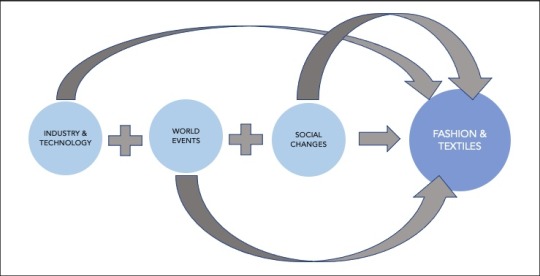
The growth of the fashion industry, caused by the industrial revolution (1870-1900s) enabled the suffragettes to use fashion as a form of branding to help promote their cause.
“They are, of course, only following in the honourable tradition set over a century ago by the suffragettes, who harnessed fashion, and the meaning of colour, as methods of communication in the early days of photography. In 1908 Emmeline Pethick-Lawrence devised the scheme of purple for dignity, white for purity and green for hope - branding for the cause, which triggered Liberty and Selfridges to start selling ranges of tricolour ribbon, underwear, bags and soap. Christina Broom��documented marches of thousands of suffragists and suffragettes wearing white dresses designed to prove to the country the dignity of their cause.”
The Guardian Cally Blackman 8.10.15 How the Suffragettes used fashion to further the cause.
https://www.theguardian.com/fashion/2015/oct/08/suffragette-style-movement-embraced-fashion-branding
1940’s
Utility Clothing Scheme: aimed to save fabric by using economical designs, eliminating laborious technical details and limiting the choice of fabrics - all to save costs.
BBC News 5.3.2015 How did WW2 change the way people dressed?
https://www.bbc.co.uk/news/magazine-31719704
1942
“Make Do and Mend was a pamphlet issued by the British Ministry of Information in the midst of WWII. It was intended to provide housewives with useful tips on how to be both frugal and stylish in times of harsh rationing. With its thrifty design ideas and advice on reusing old clothing, the pamphlet was an indispensable guide for households. Readers were advised to create pretty ‘decorative patches’ to cover holes in warm garments; unpick old jumpers to re-knit chic alternatives; turn men’s clothes into women’s; as well as darn, alter and protect against the ‘moth menace’.
Manage with and repair the possessions one already has rather than buying replacements. "the austerity of the war years taught her to make do and mend" British Library, Learning resources https://www.bl.uk/learning/timeline/item106365.html
Examples of “make do and mend” women’s suit made out of a man’s pin stripe suit, a child’s cloak made from an old blanket.


BBC News 5.3.2015 How did WW2 change the way people dressed? Fashion on the Ration is at the Imperial War Museum, London, until 31 August 2015.
https://www.bbc.co.uk/news/magazine-31719704

The “New Look” exploded in Paris in 1947 (in contrast to the utilitarian approach adopted in the war) lead by the pioneering designer Christian Dior, who empowered women through fashion.
“Throughout the war, cloth and labour shortages had limited the amount of fabric and trimming that could be used… jackets had been masculine, shoulders square and skirts short and straight… belts, seams, collars and trouser turn-ups had to conform to certain restrictions …” Yet, only two years after the end of the war, here were ankle-length skirts whose hems measured up to 40 metres in circumference. Here was a fashion that emphasised femininity, with rounded shoulders, waists nipped in tight, and hips and busts exaggerated by bodices and padding.
The New Looks striking stylistic legacy lived on well into the 1960s.
https://www.independent.co.uk/life-style/fashion/news/the-look-that-shocked-the-world-1278048.html
https://www.telegraph.co.uk/fashion/events/how-haute-couture-rescued-war-torn-paris/
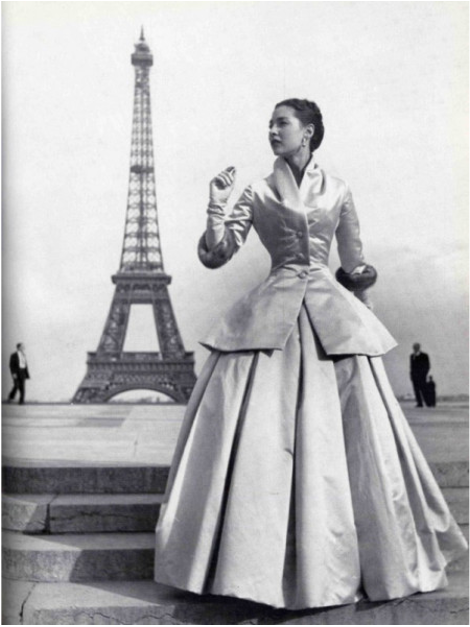
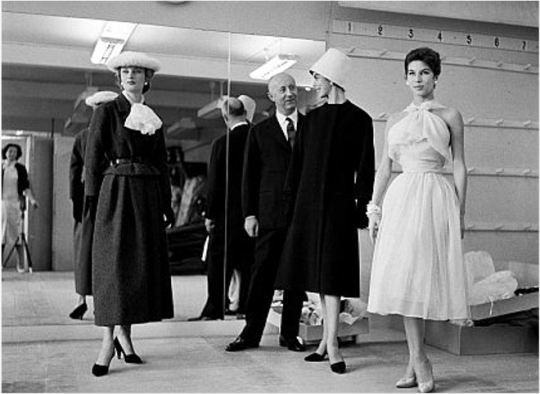
”Women, with their sure instincts, realized that my intention was to make not just more beautiful but also happier,” said Dior: A businessman as well as a poet, he made fashion responsible for expressing society's desires, and showed it how to communicate…” ref book Dior
My weakness ... is architecture. I think of my work as ephemeral architecture, dedicated to the beauty of the female body.
http://www.catwalkyourself.com/fashion-history/1950s-1960s/
Assouline publishing 2004 Dior Marie - France Pochna

Working in groups based on the following decades: 1960s, 1970s, 1980s, 1990s and 2000s. In our group we researched fashion in the 2000s. We made a mind map that considered the above influencing factors that have impacted on the fashion designers from this decade. We recorded the effect of these causes and how they have driven the design, materials and production at this time.
2000s Fashion:
Casual clothing and leisurewear were big trends in the early 2000s, a casual look for women would have been, crop tops, hoodies, low-rise flared jeans, cargo pants, daisy dukes, jean skirts, off the shoulder tops, ribbed sweaters, with platform sandals, ugg boots, or sneakers.
After researching I found technology and Y2K bug (problem in the coding of computerized systems that was projected to create havoc in computers and computer networks around the world at the beginning of the year 2000) had a huge impact on fashion in the early 2000s. The colour palette was full of shiny black tones and reflective metallics. The Y2K trend was worn on a daily but mainly reserved for going out. Popular outfits for women included mesh or handkerchief tops, box-pleated or leather skirts, shiny pants, and sparkly shoes. Britney Spears was a trendsetter for this type of style. For men, Y2K looks involved leather jackets, a statement dress shirt, and chunky shoes.
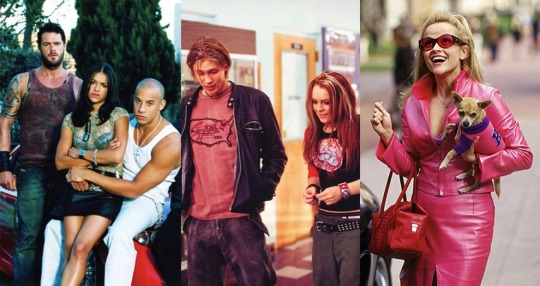
Mid 2000s fashion - Fashion started to take cues from 1960s bohemian looks. Yoga pants, low-rise jeans, cowl-neck shirts, peasant tops, capri pants, cropped jackets, and dresses over jeans was a popular outfit choice for women. These outfits were paired with accessories, such as, chunky belts, aviator sunglasses, jelly bracelets, ties worn around the neck or as belts, ballet flats, and platform boots. The 1960s revival looks were also popular with men. Including light wash bootcut jeans, cargo shorts, classic rock t-shirt, fitted cowboy shirts, henleys, polos with popped collars, and seersucker suits.
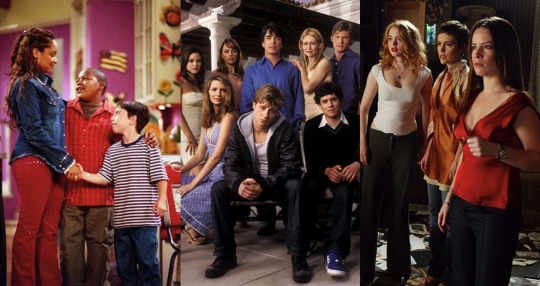
Late 2000s fashion - For women, crop tops were replaced with camisoles and miniskirts, bubble skirt, and sweater dresses. There was also a 1980s and 1990s revival of neon colours, animal prints, geometric shapes, light denim jeggings, and ripped acid washed jeans that were worn with gladiator sandals, ballet flats, and headbands. The oversized look became popular, but it was more subtle than the traditional 80s fit. Men’s late 2000s fashion was a mix of 1950s and 1980s throwbacks, with letterman and black leather jackets, overcoats, slim cut jeans, Ed Hardy t-shirts, flannel shirts, and V-neck sweaters. Paired with dad hats, wayfarers or aviators, motorcycle boots, converse, vans, or sneakers.
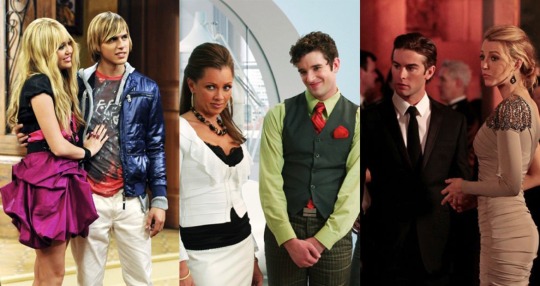
Hip-Hop had a influence on the 2000s fashion, many rappers influenced fashion with their own clothing lines. Including Jay-Z, Diddy, Nelly, and 50 Cent. Many looks included baggy jeans, tall t-shirts, sports jerseys, velour suits, bubble jackets, and puffer vests paired with headbands, sweatshirts, Timberland boots, and sneakers like Adidas Superstars or Nike Air Force 1s.

Streetwear is brand focused casual clothing, like jeans, tees, and sneakers. In the late 2000s popular streetwear styles included distressed skinny jeans, loose fitting tops, loose or fitted tracksuits, track pants, hoodies, graphic t-shirts, vintage thrift shop tees, and Tommy Hilfiger and U.S. Polo Assn brands. Sneakers were an important part of the style, retro Nike Air Jordans and Adidas Yeezys.

Emo fashion became popular in the mid 2000s and took cues from goth and punk styles. Outfits were often all or mainly black with skinny jeans, band t-shirts, studded belts, and checkered vans. Every emo look was completed with the right hairstyle, choppy cuts with long side-swept bangs dyed black, platinum blonde, or a bright colour.

Athleisure Wear - If you wanted to be comfortable yet fashionable in the early 2000s the velor tracksuits was the go to. Britney Spears, Beyonce and Eminem to Diddy were on on the tracksuit craze. They were brightly coloured and emblazoned with rhinestone logos and phrases. It was also in to mix track pants with dress clothing and design shoes to elevate the look.

The Beatles were one of the most influential bands in history, taking their fans on a journey of fashion styles through the decades from rock to teddy boys to hippie years.
(1962-1964) - (1964-1966)
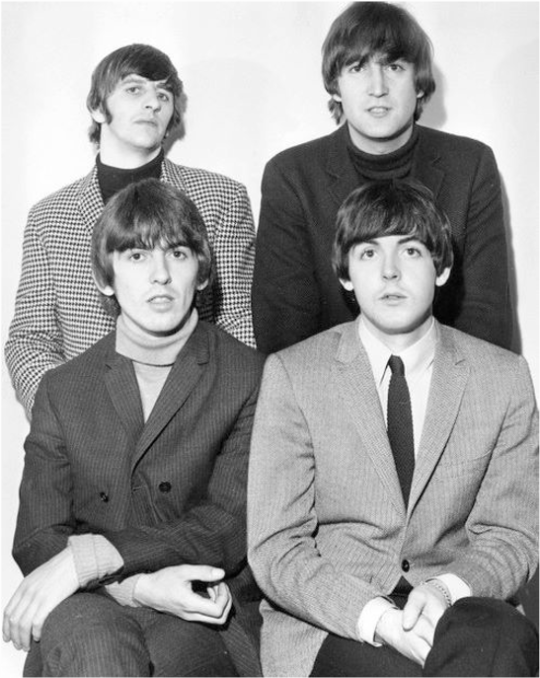
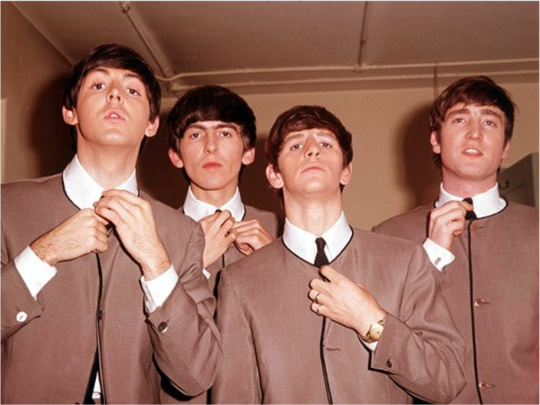
Did technology play a part in influencing this style?
During this lecture we watched a video called The Beatles Yellow Submarine.
Exaggerated shoulder pads epitomises the Power Dressing of the 1980’s.
https://www.youtube.com/watch?v=uOlwwoZLoKE&feature=youtu.be

In the 1980s Power Dressing in the UK grew from a new money focused generation, in London, creating a bee style. This look was patented by shows such as Dynasty and Dallas, where actors such as Joan Collins and Linda Evans dressed as female power dresses. Shoulder-pads and sharply tailored suits ruled and has been continued to be used by women today to signify power.
https://www.independent.co.uk/life-style/fashion/features/what-is-power-dressing-1807353.html

THATCHER USED FASHION AS A POLITICAL TOOL
“With ‘power dressing’ she could tap into the image of a career woman but her reputation as a fierce leader then drove her to wear clothes that might ‘soften’ her image, which was why she wore pussy bow blouses. A symbol of the past reflecting a more conservative femininity, the pussy bow blouse clashed with the aggressive power suits. “This was the paradox of the Thatcher image: at once she sought to embody conservative values while also seeking to assert her right to power as a woman. Dr Tyan”
https://www.independent.co.uk/life-style/fashion/margaret-thatcher-clothes-dress-suits-power-dressing-fashion-impact-women-victoria-and-albert-museum-a7480026.html
Margaret Thatcher: Fashion as a Political Tool
https://www.youtube.com/watch?v=qynZ0NEHH4M&feature=youtu.be
How did Margaret Thatcher change Britain:
Privatisation
London became a leading financial capital
Open all hours
The decline of the north
Lessened role of trade unions
Northern Ireland peace process
Education reforms – league tables
Home ownership
Power dressing
Prestige for armed forces (Falklands)
Transformed Labour party
Julian Coman Sun 14 Apr 2013 10.00 BST https://www.theguardian.com/politics/2013/apr/14/margaret-thatcher-20-changes-britain
My own research on Margaret Thatcher -
When looking at pictures of Margaret Thatcher, after the election in 1979, a well-dressed woman with her individual style is clearly shown. She began to create her image and appearance as an example of how women in power should dress. Thatcher was a confident and stern business woman however there was a clear contrast to the feminine clothing she wore. She used her clothing and style as an act of self - definition that disguised herself from others showing her individual identity as Prime Minister. Thatcher styled herself appropriately for political occasions, the most occuring colour Thatcher wore was royal blue. With her power suits and the legendary pussybow blouses, that made her a fashion icon, she was known for her haircut, her pearls, and her handbag. Her hairstyle was one of the famous features of Margaret Thatcher, as straight and precise as the lady herself.
One great example on how her style, outfits and political power were set together was before she became Prime Minister. Thatcher wore hats because not only they suited her well but were symbols of her status and class. As the leader of a major political party, her hats seemed to be a political problem. It was a problem because middle class people with conventional attitudes were prejudiced towards her. This was not the picture of a leader the party wanted to draw. Consequently, after her election to British Prime Minister she only wore hats for State ceremonies and foreign tours but not on polictail occasions anymore.
The Fashion World Supports Pussy Riot
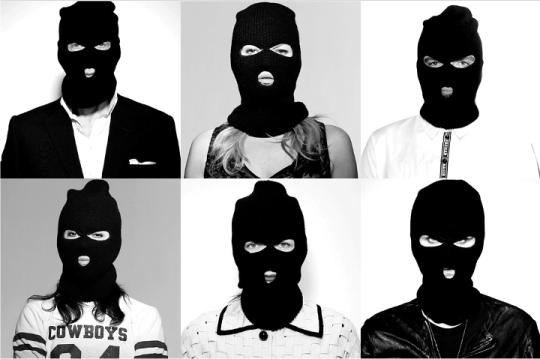

Fashion empowered to dictate and influence world events and social changes
17th April 2015 Jamie Waters Fashion’s most iconic political statements; The fashion world supports pussy riot & we’d rather go naked than wear fur.
https://www.dazeddigital.com/fashion/article/24414/1/fashion-s-most-iconic-political-statements
https://www.vogue.co.uk/article/clothing-fashion-protest
In pairs with reference to the timeline identify another advancement in technology that has impacted on social events, which in turn has driven a change in the fashion industry?
....
Brand Report
In groups we researched information about the brand Lazy Oaf, we created a detailed report which covers each of the 8 elements that make a band pitch. These elements include: Vision & purpose, brand identity, customer, price, product, place, promotion and packaging. In our group we decided to each choose an element to research and talk about, I picked promotion.
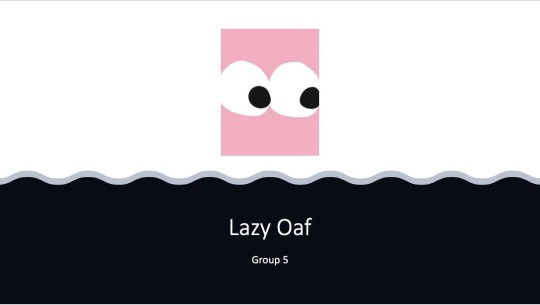


Lazy Oaf’s Brand Identity is definitely something I would take away and incorporate into our brand. We want to create personal products that our customers love and respect. Minimize environmental hazards through being sustainable but with fair prices. We also discussed as a group giving back to charities with a percentage of money we make as a brand.
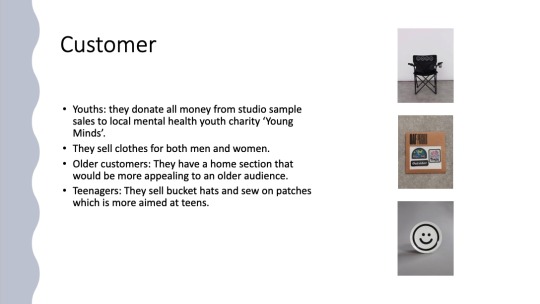



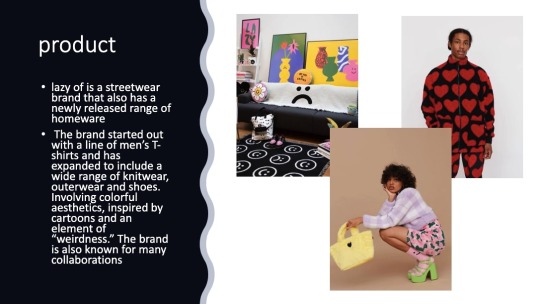
This group task gave us practice with working together, assigning roles and discussing information online. We decided to split the work fairly so that everyone had an equal amount of work to research and present. As we had to present this group task to our peers it helped us practice for when we present our brand.
13 notes
·
View notes
Text
On Ghilan’nain
When dealing with her name we all think of the halla. Maybe imagine she and Andruil were ancient elvhen girlfriends. And we might remember there could be mysterious giant sea monsters molded by her hands still lurking in the deep that she never got rid of.
As with the rest of the Evanuris we barely have a handful of codex entries on her, so there’s plenty to speculate. Recently, however, there have been a couple of ...developments.
First things first though, what is her origin story? There are a couple of differing versions. On The Ascension it’s said Ghilan’nain kept herself away from the People and spent her time creating monsters, and when Andruil tired of hunting the wild creatures she approached Ghilan’nain with a proposition: to stop, destroy her creations and join them in their godhood. Ghilan’nain accepted and began ending her creatures but spared a few -some of the air offered to Andruil as gifts, those in deep sea that Pride stopped her from killing, and the halla that she was very fond of. This implies Ghilan’nain created the halla herself.
However, in Mother of the Halla, it was Andruil who created the halla, by turning Ghilan’nain into one to help her find her way home after the attack of a resented hunter she had cursed. In this story Ghilan’nain was already one of the People, and didn’t spend her time creating monsters but being a huntress dedicated to Andruil’s Way being a devout follower.
In the Halla codex, Ghilan’nain is referred to as “first halla and mother of them all” but there’s no clarification of how she became the first halla.
So either she created the halla herself, or she was turned into the first halla by Andruil. The latter could be a metaphorical reading, as Andruil being the one inviting Ghilan’nain to join the Evanuris could be interpreted as her being the “creator” of Ghilan’nain. I’m partial to the first take, that Ghilan’nain created all those creatures and the story from Mother of Halla just take a few liberties to illustrate Andruil answering her prayers.
What of her character? Most of what we know of the Evanuris comes from myths and biased sources, there’s not enough for a full picture but we do get some small glimpses. As Solas mentioned at the temple of Mythal, the Evanuris were not as the elves like to portray them. They were flawed, violent, war-hungry, abusive, and could have destroyed the entire world had he not locked them away. We see the halla and maybe think it’s cute and such an innocent-looking creature, and may had thought similarly of Ghilan’nain, as this ancient elvhen girl who crafted a variety of creatures with her magic and was so good at it she received the favour of her gods. Thing is, as it turns out, her gods were not particularly good, so what exactly would the kind of gods who promoted war to enjoy their worship valued and found of interest in Ghilan’nain? Were her monsters a threat they didn’t wish to deal with so they wanted her on their side instead? It’s possible, but so is that they saw part of themselves in her, and I think it’s no small detail that we’re introduced to Ghilan’nain through Andruil.
It’s evident from what stories have survived time that Andruil was impulsive and prone to violence. As the Huntress she undulged in the practice to the point of losing herself in it. The thrill for the hunt led her to go after bigger and more dangerous game until she descended into the Void to go after blighted creatures, tainting herself in the process and spreading disease onto the land on her return. Mythal had to intervene, deceiving her and essentially whiping her memory so Andruil wouldn’t remember how to reach the Void, making her stop using it as hunting ground.
In relation to Ghilan’nain , this is also how they may have met. We can’t separate this two, it’s like they come in a set: the huntress and the monsters maker. The two put together make this vicious, wild loop were both can indulge endlessly; it hasn’t been mentioned yet that Ghilan’nain resented Andruil for killing her creations or that she was devastated at all at having to kill them herself. In fact, she seems to have agreed without protest to destroying her work in exchange for a seat at the big table. This, and that Andruil made the offer to begin with, says plenty of what sort of person Ghilan’nain may have been.
It’s kind of implied the two were together, although we don’t really know enough about ancient elvhen relationships. On one of Fen’Harel’s stories told by Felassan in The Masked Empire, it’s said Andruil once caught him for hunting halla without her permission and her punishment for it was to keep him as a sex slave for a year and a day. He escaped but it’s strange that Andruil would demand such a thing. Either she and Ghilan’nain weren’t really partners, were in an open relationship, or she’s just an opportunistic cheater.
Back to Ghilan’nain, it’s in Tevinter Nights, specifically The Horror of Hormak, where it’s heavily implied she was nothing like her precious halla. In this story a couple of Grey Wardens on a rescue mission find underground ruins seemingly dwarven at first that turned out to be actually elvhen. A series of mosaics decorating the walls at first glance show gracious rulers helping and healing people but the images soon twist into showing the rulers as cruel and the people subjected to harm, and what at first looked like halla pulling on aravels soon became insectoid creatures pulling on caged cargo headed to different destinations resembling different mountain locations. The one where the Wardens found themselves at held a chamber of horrors, with odd coloured lyrium pending over a pool of a strange sustance that mutated everything that came close enough. Having been told time and time again that Ghilan’nain created beings so monstrous the other elvhen gods asked her to stop and kill them, this is the first time we get an idea of how she went through her creative process.
Throughout the story there are mentions of a terrible “She” and the persistent smell of brine, and all these put together point to this chamber -and potentially many others – being where Ghilan’nain played god, or as I put it in a previous post “gene-splicing anything that moved”. Could it be Andruil’s madness got to her as well? It’s a possibility, just as likely as her being awful on her own. One of the Wardens survived the horror they found there and we know his concern was the other locations depicted in the mosaics and warning the others about it, so there’s a possibility we get to visit at the very least one of these locations.. maybe the dwarven place we got from the BTS video could be one.
Another mention of her in the lore is the Ancient Elven Writing, where it’s said it was Ghilan’nain who “urged” a servant or follower of Dirthamen to commit treason by taking on a form reserved for the gods. There’s no idication as to why she’d do such a thing, why specifically to one who belonged to a different Creator or even, if that wasn’t the case, why this person would include her name in their lie as if to frame her somehow. I can only make sense of it within my previous theory of the Evanuris, where I propose June, Sylaise and Dirthamen may have been not too awful and even secretely aided Fen’Harel somewhow. Maybe.
While Elgar’nan, Falon’din and Andruil were definitiely the bad guys that most likely plotted to kill Mythal, Ghilan’nain would have sided with Andruil, and there we have potential motivation. Pushing a follower of Dirthamen into commiting a most offensive crime would compromise Dirthamen as well, but if he was with them why do it? For so long we’ve been led to believe the Evanuris were at war with the Forgotten Ones, but it’s likely they also fought each other. We can’t know for sure if Mythal still lived when that episode took place, as the codex says “she will not show him favour and will let Elgar’nan judge him”, which can also be read as “she didn’t show up so Elgar’nan will judge instead”and i find that weird considering Mythal cared for the people and one would assume took her role as judge seriously. She may have decided to pass on that one for whatever reason, but there’s still a possibility she may had already been murdered by then and this was Elgar’nan taking over to execute those who served his enemies, in this case with the aid of Ghilan’nain. I’m definitely adding her to my Evanuris who suck list for now.
Considering some of the concept art we got in the BTS video, specifically these


..i think it’s about, hmm, 70% safe to expect some Ghilan’nain nonsense in DA4. Monstruous sea creatures? Check. Monstruous creatures with miss-matched parts and insectoid features? Check. Solas threatening to lift the Veil which would free the Evanuris? Double check.
She might show up. I like that some really good fanarts are popping up, and now i’m very curious how Ghilan’nain’s canon look would be like.
20 notes
·
View notes
Text
CMP Travel Program and Section of Invertebrate Paleontology Promotes the 125th Anniversary of the Carnegie Library of Pittsburgh with an outdoor walking tour
Before Carnegie Museums of Pittsburgh (CMP) reopened to the public on June 28th, Barbara Tucker, Director of CMP’s Travel Program, talked with me about ways to reengage members and bring them back to the Oakland museums.
With knowledge about my research on the 125th Anniversary of the founding of the Carnegie Library, Barbara suggested a 90-minute outdoor walking tour around the exterior of the massive building. Starting from where the oldest portion of the building (Portal Entry) meets the newest (Museum of Art) to the front of the historic library entrance, past the Diplodocus carnegii statue, to Forbes Avenue and the entrances of the music hall, natural history museum, and fine arts museum guarded by the statues of the noble quartet.

Fig. 1
The tour was advertised on the CMP website under the Travel Program link, https://carnegiemuseums.org/things-to-do/travel-with-us/ and https://carnegiemuseums.org/kollar/, and accurately described as an activity fully compliant with CDC protocols. Within a week, the tour received overwhelming signups, which were organized by date and number of participants by Travel Program assistant Isabel Romanowski. Three tour dates were set in August and several more in September. Special private tours for donors and others in the fall continue to be arranged.
Andrew Carnegie, Founder:
As guide for an exercise that involves close observation of architectural details, I face the challenge of getting participants to imagine this section of Pittsburgh long before any of the structures around in Oakland existed. The library and museums cover five acres of flat bottom land formed by the pre-Ice Age Monongahela River more than 1.2 million years ago. In far more recent times, the land was part of the Mary Schenley Mount Airy tract of 300 acres which was donated to the City of Pittsburgh in 1889 to create Schenley Park in her honor. Andrew Carnegie, (1835 – 1919) industrialist, steel magnate, and philanthropist, in 1895 saw the site as a place to build a complex with a library, fine arts gallery, science museum, and music hall that would represent the noble quartet of literature, art, science, and music.
The Library Tour Themes:

Fig. 2
Tour groups assemble on the dark stone steps outside the Carnegie Museum of Art (CMOA) rear entrance for an introduction focusing on the two connected, but architecturally different buildings: the Beaux-Arts style Carnegie Complex, with the original structure dating to1895, and later addition to 1907, which was built by Longfellow, Alden, and Harlow using Carnegie Steel (Fig. 2), and the modern Carnegie Museum of Art, built by architect Edward Larrabee Barnes in 1974.
Two rock types distinguish the building exteriors. The older portions of the building are clad in a light grey, easily carved, 370 million-year-old Berea Sandstone from Amherst, Ohio, while the exterior and much of the interior of Museum of Art is covered in the 295 million-year-old bluish iridescence Larvikite igneous rock from Larvik, Norway. When Barnes was commissioned to build CMOA, he chose the dark rock to blend with the older building’s coal dust veneer, a grime coating that was removed when the exterior stone was cleaned in 1990.
Landscape Art and Geology:
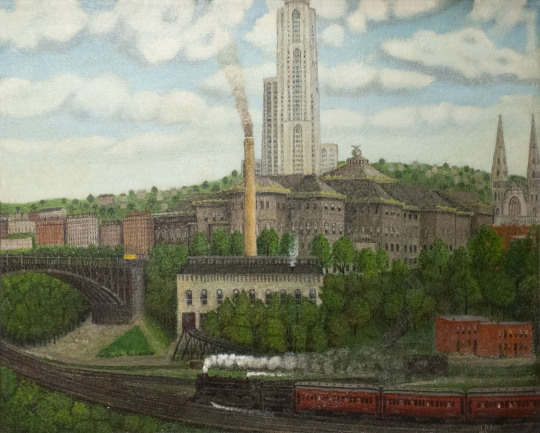
Fig. 3
Pittsburgh’s landscape painter, John Kane’s (1860 – 1934), Cathedral of Learning, circa 1930 (Fig. 3), depicts the 150-foot-deep Junction Hollow with its operating railroad. The work also includes many important architectural references, the Schenley Park Bridge (1897), Carnegie Institute’s Bellefield Boiler Plant (designed by Alden and Harlow in 1907 to supply electricity and heat to adjacent buildings), the Carnegie Institute Extension (1907), and a then unfinished Cathedral of Learning. This painting is part of CMOA Fine Arts collections.
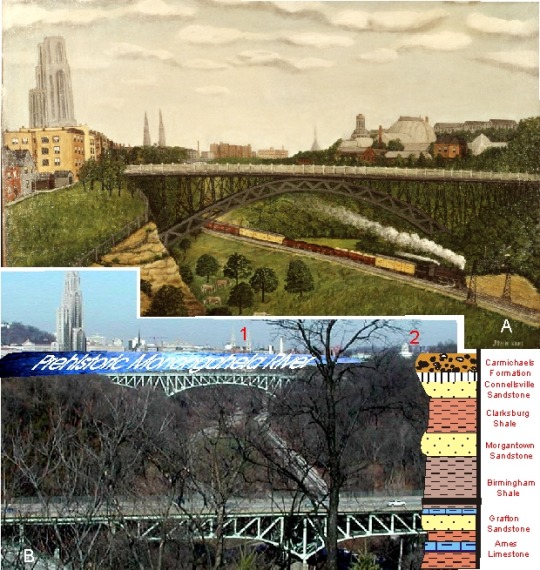
Fig. 4
Another John Kane landscape, Panther Hollow, circa 1930 – 1934, (Fig. 4A) in combination with Cathedral of Learning has been used in teaching about the 300 million-year-old geology of Schenley Park (Fig. 4B2) and the pre-Pleistocene Monongahela River that formed the flat bottom landscape of Oakland, and through erosion, Junction Hollow (Fig. 4B1). Kollar and Brezinski 2010, Geology, Landscape, and John Kane’s Landscape Paintings.
Junction Hollow Landscape:
Kane’s Cathedral of Learning (1930) is an idealized green space of Junction Hollow, the Wilmot Street Bridge in the foreground (1907) now replaced with the Charles Anderson Bridge (1940), and Carnegie Tech’s (now Carnegie Mellon University’s) Hamerschlag Hall or Machinery Hall (1912), built by Henry Hornbostel, a Pittsburgh architect. Hornbostel designed a circular Roman temple wrapped about a tall yellow brick smokestack (Fig. 4A). The design is based on the Roman temple of Vesta in Tivoli, Italy, dating to the early 1st century BC. Hornbostel’s overall campus design focused on connection between art and science, with Junction Hollow representing the geological sciences. The architect Philip Johnston, who built Pittsburgh’s postmodern PPG Place (circa 1984), once contrasted the Bellefield Boiler Plant smokestack as “the ugliest in the world to Machinery Hall’s smokestack as the most beautiful.” In novelist Michael Chabon’s debut novel, The Mysteries of Pittsburgh, (1988) the Bellefield Boiler Plant, termed “the cloud factory” by the narrator, is the setting for a pivotal scene.
Carnegie Library of Pittsburgh (Main):
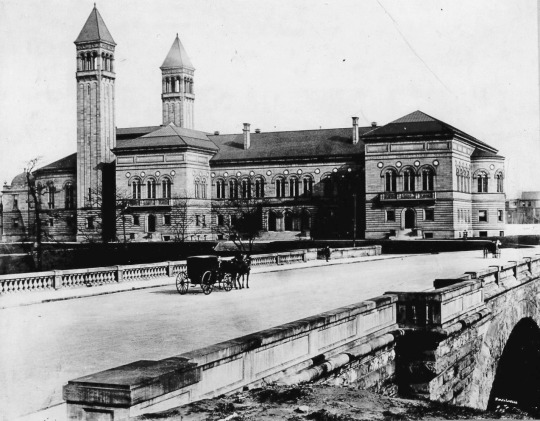
Fig. 5
The separate institutions we now know as Carnegie Museum of Natural History and Carnegie Museum of Art can track their origins to exhibits and galleries within space now fully occupied by Carnegie Library of Pittsburgh. An image of the Carnegie Library of Pittsburgh in 1902 from the Bellefield Bridge, a structure now buried under the Mary Schenley Memorial Fountain (1918), reveals eclecticism in architectural features (Fig. 5). The west facing frontage doorways and portico of the library features, CARNEGIE LIBRARY, FREE TO THE PEOPLE, and 24 carved writer names. Missing from the names is Carnegie’s favorite poet, Robert Burns, whose statue was dedicated in 1914 on the grounds of Phipps Conservancy. Three separate entrances are served by granite steps of Permian age from Vermont, one for the science museum, one for the Department of Fine Arts, and the third, with distinctive Romanesque round doorways, brass doors with intricate features, and keystone scrolling, for the Library. This entrance was designed by Harlow, who was the draftsman on the McKim, Mead, and White team responsible for the Beaux-Arts Boston Public Library (1895). When the Carnegie Institute Extension was constructed in 1907, the science museum and fine arts museum collections were moved into the new space. The former spaces in the library became the Children’s Room, Pennsylvania Room, and Music Library.

Fig. 6

Fig. 7
A challenge at this point in the tour involves discussing features that are not visible up close. The Longfellow, Alden, and Harlow’s Italian Renaissance and Beaux-Arts H-shaped parallelogram winning design featured a copula (Fig. 6) on top of the red tile roof that was never built. Eclecticism features include a double apse, a smaller shaped semi-circular extension of the library’s wall on the southside of the building, and larger apse on the north or Forbes Avenue side of the building, with the semicircular Music Hall auditorium, designed by Longfellow. The music hall exterior was structurally changed by the 1907 construction (Fig. 7).
The exterior Berea Sandstone reveals rustication masonry techniques with the cut blocks on the exterior first floor level distinguished by ashlar pillow horizontal border stone, and smooth masonry from the second floor to the cornice below the roof line. The second floor late Gothic style windows are divided by a vertical element called a mullion that helps with rigid support of the window arch and divides the window panels. Two symmetrical Campanile towers that Carnegie called “those donkey ears” were modeled after the San Marco Bell Tower in Venice, Italy. The towers served as an architectural offset to the semicircular exterior walls of the music auditorium and were removed in 1902 for the construction of the Carnegie Institute Extension. The installation of the towers can be interpreted as a tribute to Henry Hobson Richardson’s Allegheny County Courthouse twin towers (1888).
Architects choice of light grey sandstone and red tile roof:
The library’s red tile roof incorporated multiple glass roofs over the library, fine arts galleries, and science museum (all shaded from exterior sunlight today) which typified the Beau-Arts style. Keep in mind, the library did not have electric light. Light was provided by gas lighting and natural sunlight. Longfellow, Alden, and Harlow wrote that “the choice of a red tile roof and grey Ohio (Berea) Sandstone was intentional to contrast with Pittsburgh’s grey skies and the changing seasonal colors of the foliage in Schenley Park.”
The Beaux-Arts Architecture of the Carnegie Institute Extension 1907:
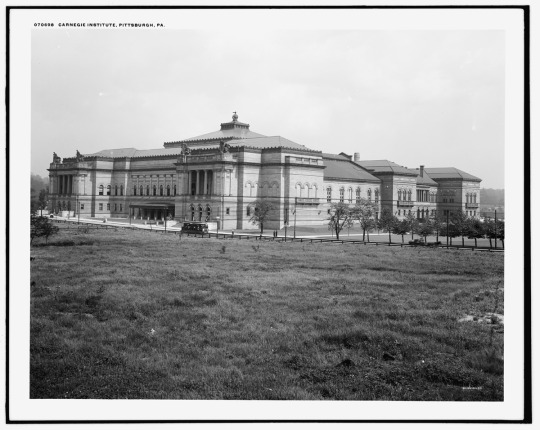
Fig. 8
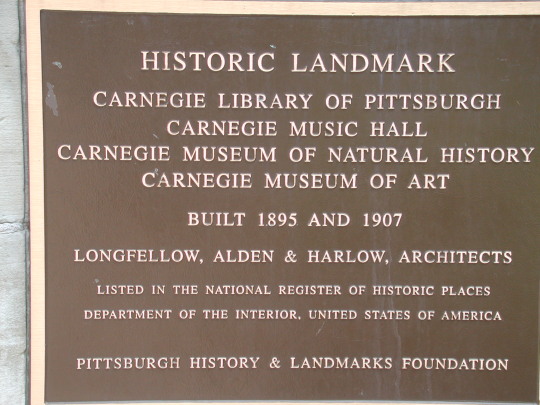
Fig. 9
After Longfellow returned to his Boston practice in 1896, Alden and Harlow received the commission to build the Carnegie Institute Extension (1907) (Fig. 8). Their efforts created one of the great Beaux-Arts building in the United States. As Cynthia Field, Smithsonian Architecture Historian, stated in 1985, “the building itself is the greatest object of the entire museum collection.” Formal recognition of the building’s architectural importance exists in two historic landmark plagues placed outside of the Carnegie Library entrance and the Museums’ Carriage Drive entrance (Fig. 9).
New exterior features of the 1907 extension work included the replacement of the red tile roof with copper, the addition of an armillary sphere, the construction, with a colonnade of solid Corinthian fluted columns of Berea Sandstone, four portico porches over the main entrances to the library, music hall, natural history and art museum, and eastside of building (now removed), and the creation, along Forbes Avenue, of a main Carriage Drive entrance with direct access to the galleries. The carved names of authors, artists, musicians, and scientists in the buildings’ entablature, a Victorian era practice, extends around the building from the library’s southeast corner to the music hall entrance, and natural history and the fine arts entrances.
Also notable along Forbes Avenue are John Massey Rhind’s noble quartet statues that guard the Music Hall and Natural History and Art entrances. The four male figures all seated in classic Greek chairs are Michelangelo (art), Shakespeare (literature), Bach (music), and Galileo (science). Standing three stories above the quartet on the edge of the roof, four groups of female allegorical figures represent literature, music, art, and science as well. The bronze figures were casted in Naples, Italy in 1907 (Fig 8).
Inside the 1907 Architecture and Building Stones:
The architects created 13 new interior spaces where three grand spaces stand out for specific architecture styles such as, the Beaux-Arts Grand Staircase (voted in 2018 as the 8th best museum staircase in the world), the Neoclassical Hall of Sculpture, and neo-Baroque Music Hall Foyer. The extension used 32 varieties of marbles and fossil limestones, many from antiquity, quarried and imported from Algeria, Croatia, France, Greece, Ireland, Italy, and the United States.
Since 2004, the collaboration between the CMP Travel Program and the Section of Invertebrate Paleontology has been highly successful reaching out to our members and patrons. This summer’s tours generated some particularly appreciative comments:
The Carnegie's resident scientists are a defining characteristic of this noble institution. Might be an anachronism in an era when museums are focused on providing 'destination' entertainment and hosting special events for swells, but while treasures like Dr. Kollar are still on staff, it’s a splendid idea to facilitate interaction between them and museum visitors. Congratulations on a most enjoyable program. -Ron Sommer
Albert was very informative and interesting. I found it most valuable learning the history of the area. -Janet Seifert
I can't stress enough how unusual and interesting it was to have a geologist give us the tour. It had never occurred to me before that there's so much one can learn about building materials from a geologist. -Neepa Majumdar
Albert D. Kollar is Collection Manager and Carnegie’s Historian of the Carnegie’s Building Stones. Barbara Tucker is Director of Carnegie Travel Program.
14 notes
·
View notes